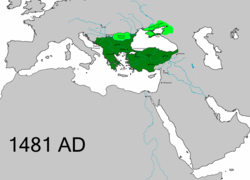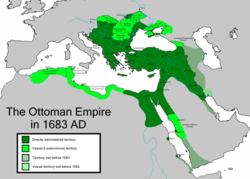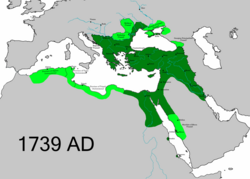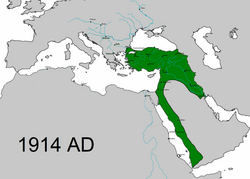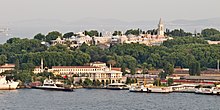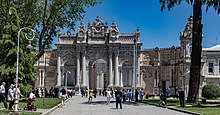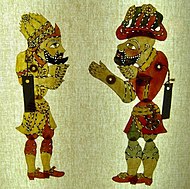Ottoman Empire
TheOttoman Empire,[j]historically and colloquially known as theTurkish Empire,[24][25]was anempire[k]centred in Anatolia that controlled much ofSoutheast Europe,West Asia,andNorth Africafrom the 14th to early 20th centuries; it also controlled parts of southeasternCentral Europebetween the early 16th and early 18th centuries.[26][27][28]
The empire emerged from abeylik,orprincipality,founded in northwesternAnatoliain 1299 by theTurkomantribal leaderOsman I.His successorsconqueredmuch of Anatolia and expanded into theBalkansby the mid-14th century, transforming theirpetty kingdominto a transcontinental empire. TheByzantine Empirewas ended with theconquest of Constantinoplein 1453 under the Ottoman sultanMehmed II,which marked the Ottomans' emergence as a major regional power. UnderSuleiman the Magnificent(1520–1566), the empire reached the peak of its power, prosperity, and political development. By the start of the 17th century, the Ottomans presided over32 provincesand numerousvassal states,which over time were either absorbed into the Empire or granted various degrees of autonomy.[l]With its capital atConstantinople(modern-dayIstanbul) and control over a significant portion of theMediterranean Basin,the Ottoman Empire was at the centre of interactions between theMiddle EastandEuropefor six centuries.
While the Ottoman Empire was once thought to have entered aperiod of declineafter the death of Suleiman the Magnificent, modern academic consensus posits that the empire continued to maintain a flexible and strong economy, society and military into much of the 18th century. However, during a long period of peace from 1740 to 1768, the Ottoman military system fell behind those of its chief European rivals, theHabsburgandRussian empires.The Ottomans consequently suffered severe military defeats in the late 18th and early 19th centuries, culminating in the loss of both territory andglobal prestige.This prompted a comprehensive process of reform and modernization known as theTanzimat;over the course of the 19th century, the Ottoman state became vastly more powerful and organized internally, despite suffering further territorial losses, especially in the Balkans, where a number of new states emerged.
Beginning in the late 19th century,various Ottoman intellectualssought to further liberalize society and politics along European lines, culminating in theYoung Turk Revolutionof 1908 led by theCommittee of Union and Progress(CUP), which established theSecond Constitutional Eraand introducedcompetitive multi-party electionsunder a constitutional monarchy. However, following the disastrousBalkan Wars,the CUP became increasingly radicalized and nationalistic,leading a coup d'étatin 1913 that established a one-party regime. The CUP allied with theGerman Empirehoping to escape from the diplomatic isolation that had contributed to its recent territorial losses; it thus joinedWorld War Ion the side of theCentral Powers.While the empire was able to largely hold its own during the conflict, it struggled with internal dissent, especially theArab Revolt.During this period, the Ottoman government engaged ingenocideagainstArmenians,Assyrians,andGreeks.
In theaftermath of World War I,the victoriousAllied Powersoccupied andpartitionedthe Ottoman Empire, which lost its southern territories to theUnited Kingdom and France.The successfulTurkish War of Independence,led byMustafa Kemal Atatürkagainst the occupying Allies, led to the emergence of theRepublic of Turkeyin the Anatolian heartland and theabolition of the Ottoman monarchyin 1922, formally ending the Ottoman Empire.
Name
The wordOttomanis a historicalanglicisationof the name ofOsman I,the founder of the Empire and of the rulingHouse of Osman(also known as the Ottoman dynasty). Osman's name in turn was the Turkish form of the Arabic nameʿUthmān(عثمان). InOttoman Turkish,the empire was referred to asDevlet-i ʿAlīye-yi ʿOsmānīye(دولت عليه عثمانیه),lit. 'Sublime Ottoman State',or simplyDevlet-i ʿOsmānīye(دولت عثمانيه),lit. 'Ottoman State'.
The Turkish word for "Ottoman" (Osmanlı) originally referred to the tribal followers of Osman in the fourteenth century. The word subsequently came to be used to refer to the empire's military-administrative elite. In contrast, the term "Turk" (Türk) was used to refer to the Anatolian peasant and tribal population and was seen as a disparaging term when applied to urban, educated individuals.[30][31]In theearly modern period,an educated, urban-dwelling Turkish speaker who was not a member of the military-administrative class typically referred to themselves neither as anOsmanlınor as aTürk,but rather as aRūmī(رومى), or "Roman", meaning an inhabitant of the territory of the formerByzantine Empirein the Balkans and Anatolia. The termRūmīwas also used to refer to Turkish speakers by the other Muslim peoples of the empire and beyond.[32]As applied to Ottoman Turkish speakers, this term began to fall out of use at the end of the seventeenth century, and instead the word increasingly became associated with the Greek population of the empire, a meaning that it still bears in Turkey today.[33]
In Western Europe, the names Ottoman Empire, Turkish Empire and Turkey were often used interchangeably, with Turkey being increasingly favoured both in formal and informal situations. This dichotomy was officially ended in 1920–1923, when the newly establishedAnkara-basedTurkish governmentchose Turkey as the sole official name. According toSvat Soucek,most scholarly historians at present avoid the terms "Turkey", "Turks", and "Turkish" when referring to the Ottomans, due to the empire's multinational character.[34]
History
| Historyof the Ottoman Empire |
|---|
 |
| Timeline |
| Historiography(Ghaza,Decline) |
The Ottoman Empire was foundedc. 1299byOsman Ias a smallbeylikin northwesternAsia Minorjust south of the Byzantine capitalConstantinople.In 1326, the Ottomans captured nearbyBursa,cutting off Asia Minor from Byzantine control. The Ottomans first crossed into Europe in 1352, establishing a permanent settlement atÇimpe Castleon theDardanellesin 1354 and moving their capital toEdirne(Adrianople) in 1369. At the same time, thenumerous small Turkic statesin Asia Minor were assimilated into the budding Ottoman sultanate through conquest or declarations of allegiance.
As SultanMehmed IIconquered Constantinople(today namedIstanbul) in 1453, transforming it into the new Ottoman capital, the state grew into a substantial empire, expanding deep into Europe, northern Africa and the Middle East. With most of theBalkansunder Ottoman rule by the mid-16th century, Ottoman territory increased exponentially under SultanSelim I,who assumed theCaliphatein 1517 as the Ottomans turned east and conquered westernArabia,Egypt,Mesopotamiaand theLevant,among other territories. Within the next few decades, much of the North African coast (except Morocco) became part of the Ottoman realm.
The empire reached its apex underSuleiman the Magnificentin the 16th century, when it stretched from thePersian Gulfin the east toAlgeriain the west, and fromYemenin the south toHungaryand parts ofUkrainein the north. According to theOttoman decline thesis,Suleiman's reign was the zenith of the Ottoman classical period, during which Ottoman culture, arts, and political influence flourished. The empire reached its maximum territorial extent in 1683, on the eve of theBattle of Vienna.
From 1699onwards, the Ottoman Empire began to lose territory over the course of the next two centuries due to internal stagnation, costly defensive wars, European colonialism, andnationalist revoltsamong its multiethnic subjects. In any case, the need to modernise was evident to the empire's leaders by the early 19th century, and numerous administrative reforms were implemented in an attempt to forestall the decline of the empire, with varying degrees of success. The gradual weakening of the Ottoman Empire gave rise to theEastern Questionin the mid-19th century.
The empire came to an end in the aftermath of its defeat inWorld War I,when its remaining territory waspartitionedby theAllies.The sultanate was officially abolished by theGovernment of the Turkish Grand National Assembly in Ankaraon 1 November 1922 following theTurkish War of Independence.Throughout its more than 600 years of existence, the Ottoman Empire has left a profound legacy in the Middle East andSoutheast Europe,as can be seen in the customs, culture, and cuisine of the various countries that were once part of its realm.
Historiographical debate on the Ottoman state
| History ofTurkey |
|---|
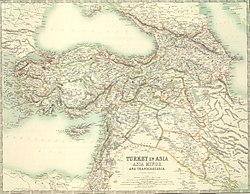 |
| Timeline |
|
|
Several historians, such as British historianEdward Gibbonand the Greek historianDimitri Kitsikis,have argued that after the fall of Constantinople, the Ottoman state took over the machinery of the Byzantine (Roman) state and that the Ottoman Empire was in essence a continuation of the Eastern Roman Empire under aTurkishMuslimguise.[35]The American historianSperos Vryoniswrites that the Ottoman state centred on "a Byzantine-Balkan base with a veneer of the Turkish language and the Islamic religion".[36]Kitsikis and the American historianHeath Lowryposit that the early Ottoman state was a predatory confederacy open to both Byzantine Christians and Turkish Muslims whose primary goal was attaining booty and slaves, rather than spreading Islam, and that Islam only later became the empire's primary characteristic.[37][38][39]Other historians have followed the lead of the Austrian historianPaul Wittek,who emphasizes the early Ottoman state's Islamic character, seeing it as a "jihadstate "dedicated to expanding theMuslim world.[36]Many historians led in 1937 by the Turkish historianMehmet Fuat Köprülüchampioned theGhaza thesis,according to which the early Ottoman state was a continuation of the way of life of the nomadicTurkic tribeswho had come from East Asia to Anatolia via Central Asia and the Middle East on a much larger scale. They argued that the most important cultural influences on the Ottoman state came fromPersia.[40]
The British historianNorman Stonesuggests many continuities between the Eastern Roman and Ottoman empires, such as that thezeugariontax of Byzantium became the OttomanResm-i çifttax, that thepronoialand-holding system that linked the amount of land one owned with one's ability to raise cavalry became the Ottomantimarsystem, and that the Ottoman land measurement thedönümwas the same as the Byzantinestremma.Stone also argues that although Sunni Islam was the state religion, the Ottoman state supported and controlled theEastern Orthodox Church,which in return for accepting that control became the Ottoman Empire's largest land-holder. Despite the similarities, Stone argues that a crucial difference is that the land grants under thetimarsystem were not hereditary at first. Even after they became inheritable, land ownership in the Ottoman Empire remained highly insecure, and the sultan revoked land grants whenever he wished. Stone argued this insecurity in land tenure strongly discouragedTimariotsfrom seeking long-term development of their land, and instead led them to adopt a strategy of short-term exploitation, which had deleterious effects on the Ottoman economy.[41]
Government
Before the reforms of the 19th and 20th centuries, thestate organisation of the Ottoman Empirewas a system with two main dimensions: the military administration and the civil administration. The Sultan was the highest position in the system. The civil system was based on local administrative units based on the region's characteristics. The state had control over the clergy. Certain pre-Islamic Turkish traditions that had survived the adoption of administrative and legal practices from IslamicIranremained important in Ottoman administrative circles.[44]According to Ottoman understanding, the state's primary responsibility was to defend and extend the land of the Muslims and to ensure security and harmony within its borders in the overarching context oforthodoxIslamic practice and dynastic sovereignty.[45]
The Ottoman Empire, or, as a dynastic institution, the House of Osman, was unprecedented and unequaled in the Islamic world for its size and duration.[46]In Europe, only theHouse of Habsburghad a similarly unbroken line of sovereigns (kings/emperors) from the same family who ruled for so long, and during the same period, between the late 13th and early 20th centuries. The Ottoman dynasty was Turkish in origin. On eleven occasions, the sultan was deposed (replaced by another sultan of the Ottoman dynasty, who were either the former sultan's brother, son or nephew) because he was perceived by his enemies as a threat to the state. There were only two attempts in Ottoman history to unseat the ruling Ottoman dynasty, both failures, which suggests a political system that for an extended period was able to manage its revolutions without unnecessary instability.[45]As such, the last Ottoman sultan Mehmed VI (r. 1918–1922) was adirect patrilineal (male-line) descendantof the first Ottoman sultanOsman I(d.1323/4), which was unparalleled in both Europe (e.g., the male line of the House of Habsburg became extinct in 1740) and in the Islamic world. The primary purpose of theImperial Haremwas to ensure the birth of male heirs to the Ottoman throne and secure the continuation of the direct patrilineal power of the Ottoman sultans in the future generations.

The highest position in Islam,caliph,was claimed by the sultans starting withSelim I,[18]which was established as the Ottoman Caliphate. The Ottoman sultan,pâdişâhor "lord of kings", served as the Empire's sole regent and was considered to be the embodiment of its government, though he did not always exercise complete control. The Imperial Harem was one of the most important powers of the Ottoman court. It was ruled by thevalide sultan.On occasion, the valide sultan became involved in state politics. For a time, the women of the Harem effectively controlled the state in what was termed the "Sultanate of Women".New sultans were always chosen from the sons of the previous sultan.[dubious–discuss]The strong educational system of thepalace schoolwas geared towards eliminating the unfit potential heirs and establishing support among the ruling elite for a successor. The palace schools, which also educated the future administrators of the state, were not a single track. First, theMadrasa(Medrese) was designated for the Muslims, and educated scholars and state officials according to Islamic tradition. The financial burden of the Medrese was supported byvakifs, allowing children of poor families to move to higher social levels and income.[47]The second track was a freeboarding schoolfor the Christians, theEnderûn,[48]which recruited 3,000 students annually from Christian boys between eight and twenty years old from one in forty families among the communities settled inRumeliaor the Balkans, a process known asDevshirme(Devşirme).[49]
Though the sultan was the supreme monarch, the sultan's political and executive authority was delegated. The politics of the state had a number of advisors and ministers gathered around a council known asDivan.The Divan, in the years when the Ottoman state was still aBeylik,was composed of the elders of the tribe. Its composition was later modified to include military officers and local elites (such as religious and political advisors). Later still, beginning in 1320, a Grand Vizier was appointed to assume certain of the sultan's responsibilities. The Grand Vizier had considerable independence from the sultan with almost unlimited powers of appointment, dismissal, and supervision. Beginning with the late 16th century, sultans withdrew from politics and the Grand Vizier became thede factohead of state.[50]
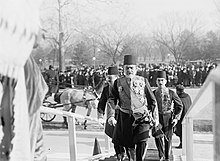
Throughout Ottoman history, there were many instances in which local governors acted independently, and even in opposition to the ruler. After the Young Turk Revolution of 1908, the Ottoman state became a constitutional monarchy. The sultan no longer had executive powers. A parliament was formed, with representatives chosen from the provinces. The representatives formed theImperial Government of the Ottoman Empire.
This eclectic administration was apparent even in the diplomatic correspondence of the Empire, which was initially undertaken in theGreek languageto the west.[51]
TheTughrawere calligraphic monograms, or signatures, of the Ottoman Sultans, of which there were 35. Carved on the Sultan's seal, they bore the names of the Sultan and his father. The statement and prayer, "ever victorious", was also present in most. The earliest belonged to Orhan Gazi. The ornately stylizedTughraspawned a branch of Ottoman-Turkishcalligraphy.
Law
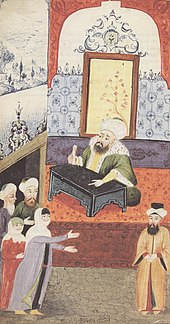
The Ottoman legal system accepted thereligious lawover its subjects. At the same time theQanun(orKanun), dynastic law, co-existed with religious law orSharia.[53][54]The Ottoman Empire was always organized around a system of localjurisprudence.Legal administration in the Ottoman Empire was part of a larger scheme of balancing central and local authority.[55]Ottoman power revolved crucially around the administration of the rights to land, which gave a space for the local authority to develop the needs of the localmillet.[55]The jurisdictional complexity of the Ottoman Empire was aimed to permit the integration of culturally and religiously different groups.[55]The Ottoman system had three court systems: one for Muslims, one for non-Muslims, involving appointed Jews and Christians ruling over their respective religious communities, and the "trade court". The entire system was regulated from above by means of the administrativeQanun,i.e., laws, a system based upon the TurkicYassaandTöre,which were developed in the pre-Islamic era.[56][57]
These court categories were not, however, wholly exclusive; for instance, the Islamic courts, which were the Empire's primary courts, could also be used to settle a trade conflict or disputes between litigants of differing religions, and Jews and Christians often went to them to obtain a more forceful ruling on an issue. The Ottoman state tended not to interfere with non-Muslim religious law systems, despite legally having a voice to do so through local governors. The IslamicSharialaw system had been developed from a combination of theQur'an;theHadīth,or words ofMuhammad;ijmā',or consensus of the members of theMuslim community;qiyas,a system of analogical reasoning from earlier precedents; and local customs. Both systems were taught at the Empire's law schools, which were inIstanbulandBursa.
The Ottoman Islamic legal system was set up differently from traditional European courts. Presiding over Islamic courts was aQadi,or judge. Since the closing of theijtihad,or 'Gate of Interpretation',Qadis throughout the Ottoman Empire focused less on legal precedent, and more with local customs and traditions in the areas that they administered.[55]However, the Ottoman court system lacked an appellate structure, leading to jurisdictional case strategies where plaintiffs could take their disputes from one court system to another until they achieved a ruling that was in their favour.

In the late 19th century, the Ottoman legal system saw substantial reform. This process of legal modernisation began with theEdict of Gülhaneof 1839.[58]These reforms included the "fair and public trial[s] of all accused regardless of religion", the creation of a system of "separate competences, religious and civil", and the validation of testimony on non-Muslims.[59]Specific land codes (1858), civil codes (1869–1876), and a code of civil procedure also were enacted.[59]
These reforms were based heavily on French models, as indicated by the adoption of a three-tiered court system. Referred to asNizamiye,this system was extended to the local magistrate level with the final promulgation of theMecelle,a civil code that regulated marriage, divorce, alimony, will, and other matters of personal status.[59]In an attempt to clarify the division of judicial competences, an administrative council laid down that religious matters were to be handled by religious courts, and statute matters were to be handled by the Nizamiye courts.[59]
Military

The first military unit of the Ottoman State was an army that was organized by Osman I from the tribesmen inhabiting the hills of western Anatolia in the late 13th century. The military system became an intricate organization with the advance of the Empire. The Ottoman military was a complex system of recruiting and fief-holding. The main corps of theOttoman Armyincluded Janissary,Sipahi,AkıncıandMehterân.The Ottoman army was once among the most advanced fighting forces in the world, being one of the first to use muskets and cannons. The Ottoman Turks began usingfalconets,which were short but wide cannons, during theSiege of Constantinople.The Ottoman cavalry depended on high speed and mobility rather than heavy armor, using bows and short swords on fastTurkomanandArabianhorses (progenitors of theThoroughbredracing horse),[60][61]and often applied tactics similar to those of theMongol Empire,such as pretending to retreat while surrounding the enemy forces inside a crescent-shaped formation and then making the real attack. The Ottoman army continued to be an effective fighting force throughout the seventeenth and early eighteenth centuries,[62][63]falling behind the empire's European rivals only during a long period of peace from 1740 to 1768.[64]
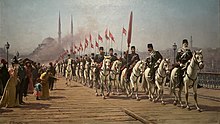
The modernization of the Ottoman Empire in the 19th century started with the military. In 1826 Sultan Mahmud II abolished the Janissary corps and established the modern Ottoman army. He named them as theNizam-ı Cedid(New Order). The Ottoman army was also the first institution to hire foreign experts and send its officers for training in western European countries. Consequently, the Young Turks movement began when these relatively young and newly trained men returned with their education.
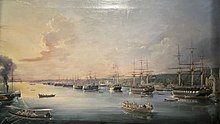
TheOttoman Navyvastly contributed to the expansion of the Empire's territories on the European continent. It initiated the conquest of North Africa, with the addition ofAlgeriaand Egypt to the Ottoman Empire in 1517. Starting with the loss of Greece in 1821 and Algeria in 1830, Ottoman naval power and control over the Empire's distant overseas territories began to decline. SultanAbdülaziz(reigned 1861–1876) attempted to reestablish a strong Ottoman navy, building the largest fleet after those of Britain and France. The shipyard at Barrow, England, built its firstsubmarinein 1886 for the Ottoman Empire.[65]
However, the collapsing Ottoman economy could not sustain the fleet's strength for long. SultanAbdülhamid IIdistrusted the admirals who sided with the reformistMidhat Pashaand claimed that the large and expensive fleet was of no use against the Russians during the Russo-Turkish War. He locked most of the fleet inside theGolden Horn,where the ships decayed for the next 30 years. Following the Young Turk Revolution in 1908, the Committee of Union and Progress sought to develop a strong Ottoman naval force. TheOttoman Navy Foundationwas established in 1910 to buy new ships through public donations.
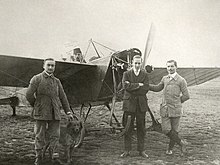
The establishment ofOttoman military aviationdates back to between June 1909 and July 1911.[66][67]The Ottoman Empire started preparing its first pilots and planes, and with the founding of the Aviation School (Tayyare Mektebi) inYeşilköyon 3 July 1912, the Empire began to tutor its own flight officers. The founding of the Aviation School quickened advancement in the military aviation program, increased the number of enlisted persons within it, and gave the new pilots an active role in the Ottoman Army and Navy. In May 1913, the world's first specialized Reconnaissance Training Program was started by the Aviation School, and the first separate reconnaissance division was established.[citation needed]In June 1914 a new military academy, the Naval Aviation School (Bahriye Tayyare Mektebi) was founded. With the outbreak of World War I, the modernization process stopped abruptly. TheOttoman Aviation Squadronsfought on many fronts during World War I, fromGaliciain the west to the Caucasus in the east andYemenin the south.
Administrative divisions

The Ottoman Empire was first subdivided into provinces, in the sense of fixed territorial units with governors appointed by the sultan, in the late 14th century.[68]
TheEyalet(alsoPashalikorBeylerbeylik) was the territory of office of aBeylerbey( "lord of lords" or governor), and was further subdivided intoSanjaks.[69]
TheVilayetswere introduced with the promulgation of the "Vilayet Law" (Teskil-i Vilayet Nizamnamesi)[70]in 1864, as part of the Tanzimat reforms.[71]Unlike the previous eyalet system, the 1864 law established a hierarchy of administrative units: the vilayet,liva/sanjak/mutasarrifate,kazaandvillage council,to which the 1871 Vilayet Law added thenahiye.[72]
Economy

Ottoman government deliberately pursued a policy for the development of Bursa, Edirne, and Istanbul, successive Ottoman capitals, into major commercial and industrial centres, considering that merchants and artisans were indispensable in creating a new metropolis.[73]To this end, Mehmed and his successor Bayezid, also encouraged and welcomed migration of the Jews from different parts of Europe, who were settled in Istanbul and other port cities like Salonica. In many places in Europe, Jews were suffering persecution at the hands of their Christian counterparts, such as in Spain, after the conclusion of theReconquista.The tolerance displayed by the Turks was welcomed by the immigrants.

The Ottoman economic mind was closely related to the basic concepts of state and society in the Middle East in which the ultimate goal of a state was consolidation and extension of the ruler's power, and the way to reach it was to get rich resources of revenues by making the productive classes prosperous.[74]The ultimate aim was to increase the state revenues without damaging the prosperity of subjects to prevent the emergence of social disorder and to keep the traditional organization of the society intact. The Ottoman economy greatly expanded during the early modern period, with particularly high growth rates during the first half of the eighteenth century. The empire's annual income quadrupled between 1523 and 1748, adjusted for inflation.[75]
The organization of the treasury and chancery were developed under the Ottoman Empire more than any other Islamic government and, until the 17th century, they were the leading organization among all their contemporaries.[50]This organisation developed a scribal bureaucracy (known as "men of the pen" ) as a distinct group, partly highly trained ulama, which developed into a professional body.[50]The effectiveness of this professional financial body stands behind the success of many great Ottoman statesmen.[76]

Modern Ottoman studies indicate that the change in relations between the Ottoman Turks and central Europe was caused by the opening of the new sea routes. It is possible to see the decline in the significance of the land routes to the East as Western Europe opened the ocean routes that bypassed the Middle East and the Mediterranean as parallel to the decline of the Ottoman Empire itself.[77][failed verification]TheAnglo-Ottoman Treaty,also known as theTreaty of Balta Limanthat opened the Ottoman markets directly to English and French competitors, can be seen as one of the staging posts along with this development.
By developing commercial centres and routes, encouraging people to extend the area of cultivated land in the country and international trade through its dominions, the state performed basic economic functions in the Empire. But in all this, the financial and political interests of the state were dominant. Within the social and political system they were living in, Ottoman administrators could not see the desirability of the dynamics and principles of the capitalist and mercantile economies developing in Western Europe.[78]
Economic historianPaul Bairochargues thatfree tradecontributed todeindustrialisationin the Ottoman Empire. In contrast to theprotectionismof China, Japan, and Spain, the Ottoman Empire had aliberal tradepolicy, open to foreign imports. This has origins incapitulations of the Ottoman Empire,dating back to the first commercial treaties signed with France in 1536 and taken further withcapitulationsin 1673 and 1740, which lowereddutiesto 3% for imports and exports. The liberal Ottoman policies were praised by British economists, such asJohn Ramsay McCullochin hisDictionary of Commerce(1834), but later criticized by British politicians such as Prime Minister Benjamin Disraeli, who cited the Ottoman Empire as "an instance of the injury done by unrestrained competition" in the 1846Corn Lawsdebate.[79]
Demographics
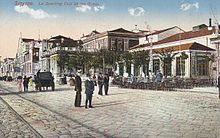
A population estimate for the empire of 11,692,480 for the 1520–1535 period was obtained by counting the households in Ottoman tithe registers, and multiplying this number by 5.[80]For unclear reasons, the population in the 18th century was lower than that in the 16th century.[81]An estimate of 7,230,660 for the first census held in 1831 is considered a serious undercount, as this census was meant only to register possible conscripts.[80]
Censuses of Ottoman territories only began in the early 19th century. Figures from 1831 onwards are available as official census results, but the censuses did not cover the whole population. For example, the 1831 census only counted men and did not cover the whole empire.[82][80]For earlier periods estimates of size and distribution of the population are based on observed demographic patterns.[83]

However, it began to rise to reach 25–32 million by 1800, with around 10 million in the European provinces (primarily in the Balkans), 11 million in the Asiatic provinces, and around 3 million in the African provinces. Population densities were higher in the European provinces, double those in Anatolia, which in turn were triple the population densities of Iraq andSyriaand five times the population density of Arabia.[84]
Towards the end of the empire's existence life expectancy was 49 years, compared to the mid-twenties in Serbia at the beginning of the 19th century.[85]Epidemic diseases and famine caused major disruption and demographic changes. In 1785 around one-sixth of the Egyptian population died from the plague and Aleppo saw its population reduced by twenty percent in the 18th century. Six famines hit Egypt alone between 1687 and 1731 and the last famine to hit Anatolia was four decades later.[86]
The rise of port cities saw the clustering of populations caused by the development of steamships and railroads. Urbanization increased from 1700 to 1922, with towns and cities growing. Improvements in health and sanitation made them more attractive to live and work in. Port cities like Salonica, in Greece, saw its population rise from 55,000 in 1800 to 160,000 in 1912 and İzmir which had a population of 150,000 in 1800 grew to 300,000 by 1914.[87][88]Some regions conversely had population falls—Belgrade saw its population drop from 25,000 to 8,000 mainly due to political strife.[87]
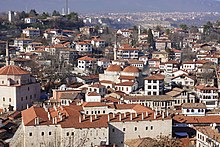
Economic and political migrations made an impact across the empire. For example, theRussianand Austria-Habsburg annexation of the Crimean and Balkan regions respectively saw large influxes of Muslim refugees—200,000 Crimean Tartars fleeing to Dobruja.[89]Between 1783 and 1913, approximately 5–7 million refugees arrived into the Ottoman Empire. Between the 1850s and World War I, about a million North Caucasian Muslims arrived in the Ottoman Empire as refugees.[90]Some migrations left indelible marks such as political tension between parts of the empire (e.g., Turkey and Bulgaria), whereas centrifugal effects were noticed in other territories, simpler demographics emerging from diverse populations. Economies were also impacted by the loss of artisans, merchants, manufacturers, and agriculturists.[91]Since the 19th century, a large proportion of Muslim peoples from the Balkans emigrated to present-day Turkey. These people are calledMuhacir.[92]By the time the Ottoman Empire came to an end in 1922, half of the urban population of Turkey was descended from Muslim refugees from Russia.[93]
Language
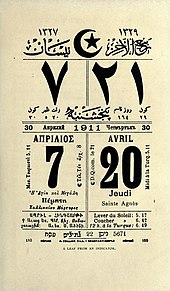
Ottoman Turkishwas the official language of the Empire.[94]It was anOghuzTurkic languagehighly influenced byPersianandArabic,though lower registries spoken by the common people had fewer influences from other languages compared to higher varieties used by upper classes and governmental authorities.[95]Turkish, in its Ottoman variation, was a language of military and administration since the nascent days of the Ottomans. The Ottoman constitution of 1876 did officially cement the official imperial status of Turkish.[96]
The Ottomans had several influential languages: Turkish, spoken by the majority of the people in Anatolia and by the majority of Muslims of the Balkans except some regions such asAlbania,Bosnia[97]and theMegleno-Romanian-inhabitedNânti;[98]Persian, only spoken by the educated;[97]Arabic, spoken mainly in Egypt, theLevant,Arabia,Iraq, North Africa,Kuwaitand parts of theHorn of AfricaandBerberin North Africa. In the last two centuries, usage of these became limited, though, and specific: Persian served mainly as a literary language for the educated,[97]whileArabicwas used for Islamic prayers. In the post-Tanzimatperiod French became the common Western language among the educated.[17]
Because of a low literacy rate among the public (about 2–3% until the early 19th century and just about 15% at the end of the 19th century), ordinary people had to hirescribesas "special request-writers" (arzuhâlcis) to be able to communicate with the government.[99]Some ethnic groups continued to speak within their families and neighborhoods (mahalles) with their own languages, though many non-Muslim minorities such as Greeks and Armenians only spoke Turkish.[100]In villages where two or more populations lived together, the inhabitants often spoke each other's language. In cosmopolitan cities, people often spoke their family languages; many of those who were not ethnicTurksspoke Turkish as a second language.[citation needed]
Religion

Sunni Islamwas the prevailingDīn(customs, legal traditions, and religion) of the Ottoman Empire; the officialMadh'hab(school of Islamicjurisprudence) wasHanafi.[101]From the early 16th century until the early 20th century, the Ottoman sultan also served as thecaliph,or politico-religious leader, of theMuslim world.Most of the Ottoman Sultans adhered toSufismand followedSufi orders,and believed Sufism was the correct way to reach God.[102]
Non-Muslims, particularly Christians and Jews, were present throughout the empire's history. The Ottoman imperial system was charactised by an intricate combination of official Muslim hegemony over non-Muslims and a wide degree of religious tolerance. While religious minorities were never equal under the law, they were granted recognition, protection, and limited freedoms under both Islamic and Ottoman tradition.[103]
Until the second half of the 15th century, the majority of Ottoman subjects were Christian.[55]Non-Muslims remained a significant and economically influential minority, albeit declining significantly by the 19th century, due largely to migration andsecession.[103]The proportion of Muslims amounted to 60% in the 1820s, gradually increasing to 69% in the 1870s and 76% in the 1890s.[103]By 1914, less than a fifth of the empire's population (19%) was non-Muslim, mostly made up of Jews and Christian Greeks, Assyrians, and Armenians.[103]
Islam
Turkic peoplespracticed a form ofshamanismbefore adopting Islam. TheMuslim conquest of Transoxianaunder theAbbasidsfacilitated the spread of Islam into the Turkic heartland of Central Asia. Many Turkic tribes—including theOghuz Turks,who were the ancestors of both the Seljuks and the Ottomans—gradually converted to Islam and brought religion to Anatolia through their migrations beginning in the 11th century. From its founding, the Ottoman Empire officially supported theMaturidi school ofIslamic theology,which emphasizedhuman reason,rationality,the pursuit of science andphilosophy(falsafa).[104][105]The Ottomans were among the earliest and most enthusiastic adopters of theHanafischool of Islamic jurisprudence,[106]which was comparatively more flexible and discretionary in its rulings.[107][108]
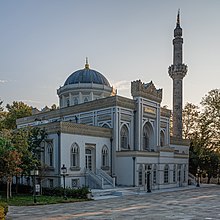
The Ottoman Empire had a wide variety of Islamic sects, includingDruze,Ismailis,Alevis,andAlawites.[109]Sufism,a diverse body of Islamicmysticism,found fertile ground in Ottoman lands; many Sufi religious orders (tariqa), such as theBektashiandMevlevi,were either established, or saw significant growth, throughout the empire's history.[110]However, some heterodox Muslim groups were viewed as heretical and even ranked below Jews and Christians in terms of legal protection; Druze were frequent targets of persecution,[111]with Ottoman authorities often citing the controversial rulings ofIbn Taymiyya,a member of the conservativeHanbali school.[112]In 1514, Sultan Selim I ordered the massacre of 40,000 Anatolian Alevis (Qizilbash), whom he considered afifth columnfor the rivalSafavid Empire.
During Selim's reign, the Ottoman Empire saw an unprecedented and rapid expansion into the Middle East, particularly theconquest of the entire Mamluk Sultanate of Egypton the early 16th century. These conquests further solidified the Ottoman claim of being anIslamic caliphate,although Ottoman sultans had been claiming the title of caliph since the reign of Murad I (1362–1389).[18]The caliphate was officially transferred from the Mamluks to the Ottoman sultanate in 1517, whose members were recognized as caliphs until theoffice's abolition on 3 March 1924by theRepublic of Turkey(and the exile of the last caliph,Abdülmecid II,to France).
Christianity and Judaism
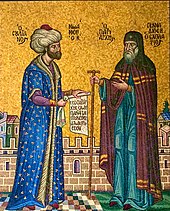
In accordance with the Muslimdhimmisystem, the Ottoman Empire guaranteed limited freedoms to Christians, Jews, and other "people of the book",such as the right to worship, own property, and be exempt from the obligatory alms (zakat) required of Muslims. However, non-Muslims (ordhimmi) were subject to various legal restrictions, including being forbidden to carry weapons, ride on horseback, or have their homes overlook those of Muslims; likewise, they were required to pay higher taxes than Muslim subjects, including thejizya,which was a key source of state revenue.[113][114]Many Christians and Jews converted to Islam to secure full social and legal status, though most continued to practice their faith without restriction.
The Ottomans developed a unique sociopolitical system known as themillet,which granted non-Muslim communities a large degree of political, legal, and religious autonomy; in essence, members of a millet were subjects of the empire but not subject to the Muslim faith or Islamic law. A millet could govern its own affairs, such as raising taxes and resolving internal legal disputes, with little or no interference from Ottoman authorities, so long as its members were loyal to the sultan and adhered to the rules concerningdhimmi.A quintessential example is the ancient Orthodox community ofMount Athos,which was permitted to retain its autonomy and was never subject to occupation or forced conversion; even special laws were enacted to protect it from outsiders.[115]
TheRumMillet,which encompassed most Eastern Orthodox Christians, was governed by the Byzantine-eraCorpus Juris Civilis(Code of Justinian), with theEcumenical Patriarchdesignated the highest religious and political authority (millet-bashi,orethnarch). Likewise,Ottoman Jewscame under the authority of theHaham Başı,or OttomanChief Rabbi,whileArmenianswere under the authority of thechief bishopof theArmenian Apostolic Church.[116]As the largest group of non-Muslim subjects, the Rum Millet enjoyed several special privileges in politics and commerce; however, Jews and Armenians were also well represented among the wealthy merchant class, as well as in public administration.[117][118]
Some modern scholars consider the millet system to be an early example ofreligious pluralism,as it accorded minority religious groups official recognition and tolerance.[119]
Social-political-religious structure

Beginning in the early 19th century, society, government, and religion were interrelated in a complex, overlapping way that was deemed inefficient by Atatürk, who systematically dismantled it after 1922.[120][121]In Constantinople, the Sultan ruled two distinct domains: the secular government and the religious hierarchy. Religious officials formed the Ulama, who had control of religious teachings and theology, and also the Empire's judicial system, giving them a major voice in day-to-day affairs in communities across the Empire (but not including the non-Muslim millets). They were powerful enough to reject the military reforms proposed by SultanSelim III.His successor SultanMahmud II(r. 1808–1839) first won ulama approval before proposing similar reforms.[122]The secularisation program brought by Atatürk ended the ulema and their institutions. The caliphate was abolished, madrasas were closed down, and the sharia courts were abolished. He replaced the Arabic alphabet with Latin letters, ended the religious school system, and gave women some political rights. Many rural traditionalists never accepted this secularisation, and by the 1990s they were reasserting a demand for a larger role for Islam.[123]

The Janissaries were a highly formidable military unit in the early years, but as Western Europe modernized its military organization technology, the Janissaries became a reactionary force that resisted all change. Steadily the Ottoman military power became outdated, but when the Janissaries felt their privileges were being threatened, or outsiders wanted to modernize them, or they might be superseded by the cavalrymen, they rose in rebellion. The rebellions were highly violent on both sides, but by the time the Janissaries were suppressed, it was far too late for Ottoman military power to catch up with the West.[124][125]The political system was transformed by the destruction of theJanissaries,a powerful military/governmental/police force, which revolted in theAuspicious Incidentof 1826. Sultan Mahmud II crushed the revolt executed the leaders and disbanded the large organization. That set the stage for a slow process of modernization of government functions, as the government sought, with mixed success, to adopt the main elements of Western bureaucracy and military technology.
The Janissaries had been recruited from Christians and other minorities; their abolition enabled the emergence of a Turkish elite to control the Ottoman Empire. A large number of ethnic and religious minorities were tolerated in their own separate segregated domains called millets.[126]They were primarilyGreek,Armenian,orJewish.In each locality, they governed themselves, spoke their own language, ran their own schools, cultural and religious institutions, and paid somewhat higher taxes. They had no power outside the millet. The Imperial government protected them and prevented major violent clashes between ethnic groups.
Ethnic nationalism, based on distinctive religion and language, provided a centripetal force that eventually destroyed the Ottoman Empire.[127]In addition, Muslim ethnic groups, which were not part of the millet system, especially the Arabs and the Kurds, were outside the Turkish culture and developed their own separate nationalism. The British sponsored Arab nationalism in the First World War, promising an independent Arab state in return for Arab support. Most Arabs supported the Sultan, but those near Mecca believed in and supported the British promise.[128]

At the local level, power was held beyond the control of the Sultan by theayansor local notables. The ayan collected taxes, formed local armies to compete with other notables, took a reactionary attitude toward political or economic change, and often defied policies handed down by the Sultan.[129]
After the 18th century, the Ottoman Empire was shrinking, as Russia put on heavy pressure and expanded to its south; Egypt became effectively independent in 1805, and the British later took it over, along with Cyprus. Greece became independent, and Serbia and other Balkan areas became highly restive as the force of nationalism pushed against imperialism. The French took over Algeria and Tunisia. The Europeans all thought that the empire was a sick man in rapid decline. Only the Germans seemed helpful, and their support led to the Ottoman Empire joining the central powers in 1915, with the result that they came out as one of the heaviest losers of the First World War in 1918.[130]
Culture
| Culture of the Ottoman Empire |
|---|
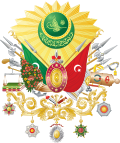 |
| Visual arts |
| Performing arts |
| Languages and literature |
| Sports |
| Other |

The Ottomans absorbed some of the traditions, art, and institutions of cultures in the regions they conquered and added new dimensions to them. Numerous traditions and cultural traits of previous empires (in fields such as architecture, cuisine, music, leisure, and government) were adopted by the Ottoman Turks, who developed them into new forms, resulting in a new and distinctively Ottoman cultural identity. Although the predominant literary language of the Ottoman Empire was Turkish, Persian was the preferred vehicle for the projection of an imperial image.[131]
Slaverywas part of Ottoman society,[132]with most slaves employed as domestic servants. Agricultural slavery, like that in the Americas, was relatively rare. Unlike systems ofchattel slavery,slaves under Islamic law were not regarded as movable property, and the children of female slaves were born legally free. Female slaves were still sold in the Empire as late as 1908.[133]During the 19th century the Empire came under pressure from Western European countries to outlaw the practice. Policies developed by various sultans throughout the 19th century attempted to curtail theOttoman slave tradebut slavery had centuries of religious backing and sanction and so was never abolished in the Empire.[116]
Plagueremained a major scourge in Ottoman society until the second quarter of the 19th century. "Between 1701 and 1750, 37 larger and smaller plague epidemics were recorded in Istanbul, and 31 between 1751 and 1801."[134]
Ottomans adopted Persian bureaucratic traditions and culture. The sultans also made an important contribution in the development of Persian literature.[135]
Language was not an obvious sign of group connection and identity in the 16th century among the rulers of the Ottoman Empire,Safavid IranandAbu'l-Khayrid ShibanidsofCentral Asia.[136]Hence the ruling classes of all three polities were bilingual in varieties of Persian and Turkic.[136]But in the century's final quarter, linguistic adjustments occurred in the Ottoman and Safavid realms defined by a new rigidity that favoured Ottoman Turkish and Persian, respectively.[136]
Education
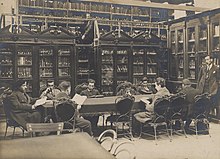
In the Ottoman Empire, eachmilletestablished a schooling system serving its members.[137]Education was therefore largely divided on ethnic and religious lines: few non-Muslims attended schools for Muslim students, and vice versa. Most institutions that served all ethnic and religious groups taught in French or other languages.[138]
Several "foreign schools" (Frerler mektebleri) operated by religious clergy primarily served Christians, although some Muslim students attended.[137]Garnett described the schools for Christians and Jews as "organised upon European models", with "voluntary contributions" supporting their operation and most of them "well attended" and with "a high standard of education".[139]
Literature
The two primary streams of Ottoman written literature are poetry andprose.Poetry was by far the dominant stream. The earliest work of Ottoman historiography for example, theİskendernâme,was composed by the poetTaceddin Ahmedi(1334–1413).[140]Until the 19th century, Ottoman prose did not contain any examples of fiction: there were no counterparts to, for instance, the Europeanromance,short story, or novel. Analog genres did exist, though, in bothTurkish folk literatureand inDivan poetry.
Ottoman Divan poetry was a highly ritualized and symbolic art form. From thePersian poetrythat largely inspired it, it inherited a wealth of symbols whose meanings and interrelationships—both of similitude (مراعات نظيرmura'ât-i nazîr/تناسبtenâsüb) and opposition (تضادtezâd) were more or less prescribed. Divan poetry was composed through the constant juxtaposition of many such images within a strict metrical framework, allowing numerous potential meanings to emerge. The vast majority of Divan poetry waslyricin nature: eithergazels(which make up the greatest part of the repertoire of the tradition), or kasîdes. But there were other common genres, especially the mesnevî, a kind ofverse romanceand thus a variety ofnarrative poetry;the two most notable examples of this form are theLeyli and MajnunofFuzuliand theHüsn ü AşkofŞeyh Gâlib.TheSeyahatnâmeofEvliya Çelebi(1611–1682) is an outstanding example of travel literature.
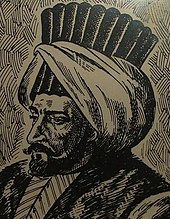
Until the 19th century,Ottoman prosedid not develop to the extent that contemporary Divan poetry did. A large part of the reason was that much prose was expected to adhere to the rules ofsec(سجع,also transliterated asseci), orrhymed prose,[141]a type of writing descended from the Arabicsaj'that prescribed that between each adjective and noun in a string of words, such as a sentence, there must be a rhyme. Nevertheless, there was a tradition of prose in the literature of the time, though it was exclusively nonfictional. One apparent exception wasMuhayyelât(Fancies) byGiritli Ali Aziz Efendi,a collection of stories of the fantastic written in 1796, though not published until 1867. The first novel published in the Ottoman Empire wasVartan Pasha's 1851The Story of Akabi(Turkish:Akabi Hikyayesi). It was written in Turkish but withArmenianscript.[142][143][144][145]
Due to historically close ties with France,French literatureconstituted the major Western influence on Ottoman literature in the latter half of the 19th century. As a result, many of the same movements prevalent in France during this period had Ottoman equivalents; in the developing Ottoman prose tradition, for instance, the influence ofRomanticismcan be seen during the Tanzimat period, and that of theRealistandNaturalistmovements in subsequent periods; in the poetic tradition, on the other hand, the influence of theSymbolistandParnassianmovements was paramount.
Many of the writers in the Tanzimat period wrote in several different genres simultaneously; for instance, the poetNamık Kemalalso wrote the important 1876 novelİntibâh(Awakening), while the journalistİbrahim Şinasiis noted for writing, in 1860, the first modern Turkish play, theone-actcomedyŞair Evlenmesi(The Poet's Marriage). An earlier play, afarcetitledVakâyi'-i 'Acibe ve Havâdis-i Garibe-yi Kefşger Ahmed(The Strange Events and Bizarre Occurrences of the Cobbler Ahmed), dates from the beginning of the 19th century, but there is doubt about its authenticity. In a similar vein, the novelistAhmed Midhat Efendiwrote important novels in each of the major movements: Romanticism (Hasan Mellâh yâhud Sırr İçinde Esrâr,1873;Hasan the Sailor, or The Mystery Within the Mystery), Realism (Henüz on Yedi Yaşında,1881;Just Seventeen Years Old), and Naturalism (Müşâhedât,1891;Observations). This diversity was, in part, due to Tanzimat writers' wish to disseminate as much of the new literature as possible, in the hopes that it would contribute to a revitalization of Ottomansocial structures.[146]
Media
The media of the Ottoman Empire was diverse, with newspapers and journals published in languages includingFrench,[147]Greek,[148]andGerman.[116]Many of these publications were centred inConstantinople,[149]but there were also French-language newspapers produced inBeirut,Salonika,andSmyrna.[150]Non-Muslim ethnic minorities in the empire used French as alingua francaand used French-language publications,[147]while some provincial newspapers were published inArabic.[151]The use of French in the media persisted until theend of the empirein 1923 and for a few years thereafter in theRepublic of Turkey.[147]
Architecture
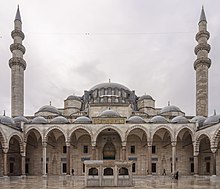
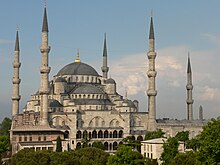
The architecture of the empire developed from earlierSeljuk Turkish architecture,with influences fromByzantineandIranianarchitecture and other architectural traditions in the Middle East.[152][153][154]Early Ottoman architectureexperimented with multiple building types over the course of the 13th to 15th centuries, progressively evolving into theClassical Ottoman styleof the 16th and 17th centuries, which was also strongly influenced by theHagia Sophia.[154][155]The most important architect of the Classical period isMimar Sinan,whose major works include theŞehzade Mosque,Süleymaniye Mosque,andSelimiye Mosque.[156][157]The greatest of the court artists enriched the Ottoman Empire with many pluralistic artistic influences, such as mixing traditionalByzantine artwith elements ofChinese art.[158]The second half of the 16th century also saw the apogee of certain decorative arts, most notably in the use ofIznik tiles.[159]
Beginning in the 18th century, Ottoman architecture was influenced by theBaroque architecturein Western Europe, resulting in theOttoman Baroquestyle.[160]Nuruosmaniye Mosqueis one of the most important examples from this period.[161][162]The last Ottoman period saw more influences from Western Europe, brought in by architects such as those from theBalyan family.[163]Empire styleandNeoclassicalmotifs were introduced and a trend towardseclecticismwas evident in many types of buildings, such as theDolmabaçe Palace.[164]The last decades of the Ottoman Empire also saw the development of a new architectural style called neo-Ottoman or Ottoman revivalism, also known as theFirst National Architectural Movement,[165]by architects such asMimar KemaleddinandVedat Tek.[163]
Ottoman dynastic patronage was concentrated in the historic capitals of Bursa, Edirne, and Istanbul (Constantinople), as well as in several other important administrative centres such asAmasyaandManisa.It was in these centres that most important developments in Ottoman architecture occurred and that the most monumental Ottoman architecture can be found.[166]Major religious monuments were typically architectural complexes, known as akülliye,that had multiple components providing different services or amenities. In addition to a mosque, these could include amadrasa,ahammam,animaret,asebil,a market, acaravanserai,aprimary school,or others.[167]These complexes were governed and managed with the help of avakıfagreement (Arabicwaqf).[167]Ottoman constructions were still abundant in Anatolia and in the Balkans (Rumelia), but in the more distant Middle Eastern and North African provinces olderIslamic architecturalstyles continued to hold strong influence and were sometimes blended with Ottoman styles.[168][169]
Decorative arts
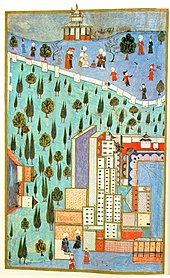
The tradition ofOttoman miniatures,painted to illustrate manuscripts or used in dedicated albums, was heavily influenced by thePersianart form, though it also included elements of theByzantinetradition ofilluminationand painting.[170]A Greek academy of painters, theNakkashane-i-Rum,was established in theTopkapi Palacein the 15th century, while early in the following century a similar Persian academy, theNakkashane-i-Irani,was added.Surname-i Hümayun(Imperial Festival Books) were albums that commemorated celebrations in the Ottoman Empire in pictorial and textual detail.
Ottoman illuminationcovers non-figurative painted or drawn decorative art in books or on sheets inmuraqqaor albums, as opposed to the figurative images of theOttoman miniature.It was a part of the Ottoman Book Arts together with the Ottoman miniature (taswir), calligraphy (hat),Islamic calligraphy,bookbinding (cilt) andpaper marbling(ebru). In the Ottoman Empire,illuminated and illustrated manuscriptswere commissioned by the Sultan or the administrators of the court. In Topkapi Palace, these manuscripts were created by the artists working inNakkashane,the atelier of the miniature and illumination artists. Both religious and non-religious books could be illuminated. Also, sheets for albumslevhaconsisted of illuminated calligraphy (hat) oftughra,religious texts, verses from poems or proverbs, and purely decorative drawings.
The art of carpetweavingwas particularly significant in the Ottoman Empire, carpets having an immense importance both as decorative furnishings, rich in religious and other symbolism and as a practical consideration, as it was customary to remove one's shoes in living quarters.[171]The weaving of such carpets originated in thenomadiccultures of central Asia (carpets being an easily transportable form of furnishing), and eventually spread to the settled societies of Anatolia. Turks used carpets, rugs, andkilimsnot just on the floors of a room but also as a hanging on walls and doorways, where they provided additional insulation. They were also commonly donated to mosques, which often amassed large collections of them.[172]
Music and performing arts

Ottoman classical musicwas an important part of the education of the Ottoman elite. A number of the Ottoman sultans have accomplished musicians and composers themselves, such asSelim III,whose compositions are often still performed today. Ottoman classical music arose largely from a confluence ofByzantine music,Armenian music,Arabic music,andPersian music.Compositionally, it is organized around rhythmic units calledusul,which are somewhat similar tometerin Western music, andmelodicunits calledmakam,which bear some resemblance to Westernmusical modes.
Theinstrumentsused are a mixture of Anatolian and Central Asian instruments (thesaz,thebağlama,thekemence), other Middle Eastern instruments (theud,thetanbur,thekanun,theney), and—later in the tradition—Western instruments (the violin and the piano). Because of a geographic and cultural divide between the capital and other areas, two broadly distinct styles of music arose in the Ottoman Empire: Ottoman classical music and folk music. In the provinces, several different kinds offolk musicwere created. The most dominant regions with their distinguished musical styles are Balkan-Thracian Türküs, North-Eastern (Laz) Türküs, Aegean Türküs, Central Anatolian Türküs, Eastern Anatolian Türküs, and Caucasian Türküs. Some of the distinctive styles were:Janissary music,Roma music,Belly dance,Turkish folk music.
The traditionalshadow playcalledKaragöz and Hacivatwas widespread throughout the Ottoman Empire and featured characters representing all of the major ethnic and social groups in that culture.[173][174]It was performed by a single puppet master, who voiced all of the characters, and accompanied bytambourine(def). Its origins are obscure, deriving perhaps from an older Egyptian tradition, or possibly from an Asian source.
-
The shadow playKaragöz and Hacivatwas widespread throughout the Ottoman Empire.
-
A musical gathering in the 18th century
-
Acrobacy inSurname-i Hümayun
Cuisine

Ottoman cuisineis the cuisine of the capital, Constantinople (Istanbul), and the regional capital cities, where the melting pot of cultures created a common cuisine that most of the population regardless of ethnicity shared. This diverse cuisine was honed in the Imperial Palace's kitchens by chefs brought from certain parts of the Empire to create and experiment with different ingredients. The creations of the Ottoman Palace's kitchens filtered to the population, for instance throughRamadanevents, and through the cooking at theYalısof thePashas,and from there on spread to the rest of the population.
Much of the cuisine of former Ottoman territories today is descended from a shared Ottoman cuisine, especiallyTurkish,and includingGreek,Balkan,Armenian,andMiddle Easterncuisines.[175]Many common dishes in the region, descendants of the once-common Ottoman cuisine, includeyogurt,döner kebab/gyro/shawarma,cacık/tzatziki,ayran,pitabread,fetacheese,baklava,lahmacun,moussaka,yuvarlak,köfte/keftés/kofta,börek/boureki,rakı/rakia/tsipouro/tsikoudia,meze,dolma,sarma,ricepilaf,Turkish coffee,sujuk,kashk,keşkek,manti,lavash,kanafeh,and more.
Sports
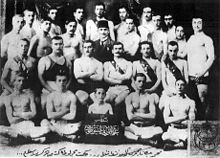
The main sports Ottomans were engaged in wereTurkish wrestling,hunting,Turkish archery,horseback riding,equestrian javelin throw,arm wrestling, and swimming. European model sports clubs were formed with the spreading popularity offootballmatches in 19th century Constantinople. The leading clubs, according to timeline, wereBeşiktaş Gymnastics Club(1903),Galatasaray Sports Club(1905),Fenerbahçe Sports Club(1907),MKE Ankaragücü (formerly Turan Sanatkarangücü)(1910) in Constantinople. Football clubs were formed in other provinces too, such asKarşıyaka Sports Club(1912),Altay Sports Club(1914) andTurkish Fatherland Football Club(laterÜlküspor) (1914) ofİzmir.
Science and technology

Over the course of Ottoman history, the Ottomans managed to build a large collection of libraries complete with translations of books from other cultures, as well as original manuscripts.[176]A great part of this desire for local and foreign manuscripts arose in the 15th century.Sultan Mehmet IIorderedGeorgios Amiroutzes,a Greek scholar fromTrabzon,to translate and make available to Ottoman educational institutions the geography book ofPtolemy.Another example isAli Qushji—anastronomer,mathematicianandphysicistoriginally fromSamarkand—who became a professor in two madrasas and influenced Ottoman circles as a result of his writings and the activities of his students, even though he only spent two or three years in Constantinople before his death.[177]
Taqi al-Dinbuilt theConstantinople observatory of Taqi ad-Dinin 1577, where he carried out observations until 1580. He calculated theeccentricityof the Sun's orbit and the annual motion of theapogee.[178]However, the observatory's primary purpose was almost certainlyastrologicalrather than astronomical, leading to its destruction in 1580 due to the rise of a clerical faction that opposed its use for that purpose.[179]He also experimented withsteam powerinOttoman Egyptin 1551, when he described asteam jackdriven by a rudimentarysteam turbine.[180]
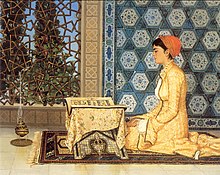
In 1660, the Ottoman scholarIbrahim Efendi al-Zigetvari TezkirecitranslatedNoël Duret's French astronomical work (written in 1637) into Arabic.[182]
Şerafeddin Sabuncuoğluwas the author of the first surgical atlas and the last majormedical encyclopaedia from the Islamic world.Though his work was largely based onAbu al-Qasim al-Zahrawi'sAl-Tasrif,Sabuncuoğlu introduced many innovations of his own. Female surgeons were also illustrated for the first time.[183]Since, the Ottoman Empire is credited with the invention of several surgical instruments in use such asforceps,catheters,scalpels and lancetsas well aspincers.[184][better source needed]
An example of a watch that measured time in minutes was created by an Ottoman watchmaker,Meshur Sheyh Dede,in 1702.[185]
In the early 19th century,Egypt under Muhammad Alibegan usingsteam enginesfor industrial manufacturing, with industries such asironworks,textile manufacturing,paper millsandhullingmills moving towards steam power.[186]Economic historian Jean Batou argues that the necessary economic conditions existed in Egypt for the adoption ofoilas a potential energy source for its steam engines later in the 19th century.[186]
In the 19th century,Ishak Efendiis credited with introducing the then current Western scientific ideas and developments to the Ottoman and wider Muslim world, as well as the invention of a suitable Turkish and Arabic scientific terminology, through his translations of Western works.
See also
- 16 Great Turkic Empires
- Bibliography of the Ottoman Empire
- Empire of the Sultans
- Gunpowder empires
- Historiography of the Ottoman Empire
- Outline of the Ottoman Empire
- List of battles involving the Ottoman Empire
- List of foreigners who were in the service of the Ottoman Empire
- List of Ottoman conquests, sieges and landings
- List of wars involving the Ottoman Empire
- Ottoman wars in Europe
- Turkic history
References
Footnotes
- ^In Ottoman Turkish, the city was known by various names, among which wereḲosṭanṭīnīye(قسطنطينيه) (replacing the suffix-poliswith the Arabic suffix),Istanbul(استنبول) andIslambol(اسلامبول,lit. 'full of Islam'); seeNames of Istanbul). Kostantiniyye became obsolete in Turkish after theproclamation of the Republic of Turkeyin 1923,[5]and after Turkey's transition to Latin script in 1928,[6]the Turkish government in 1930 requested that foreign embassies and companies useIstanbul,and that name became widely accepted internationally.[7]Eldem Edhem, author of an entry on Istanbul inEncyclopedia of the Ottoman Empire,stated that the majority of the Turkish peoplec. 2010,including historians, believe using "Constantinople" to refer to the Ottoman-era city is "politically incorrect" despite any historical accuracy.[5]
- ^Liturgical language;among Arabic-speaking citizens
- ^Court, diplomacy, poetry, historiographical works, literary works, taught in state schools, and offered as an elective course or recommended for study in somemadrasas.[8][9][10][11][12][13][14][15]
- ^Among Greek-speaking community; spoken by some sultans.
- ^Decrees in the 15th century.[16]
- ^Foreign language among educated people in the post-Tanzimat/late imperial period.[17]
- ^The sultan from 1512 to 1520.
- ^1 November 1922 marks the formal ending of the Ottoman Empire. Mehmed VI departed Constantinople on 17 November 1922.
- ^TheTreaty of Sèvres(10 August 1920) afforded a small existence to the Ottoman Empire. On 1 November 1922, theGrand National Assembly(GNAT) abolished the sultanate and declared that all the deeds of the Ottoman regime in Constantinople were null and void as of 16 March 1920, the date of theoccupation of Constantinopleunder the terms of the Treaty of Sèvres. The international recognition of the GNAT and theGovernment of Ankarawas achieved through the signing of theTreaty of Lausanneon 24 July 1923. The Grand National Assembly of Turkey promulgated the Republic on 29 October 1923, which ended the Ottoman Empire in history.
- ^/ˈɒtəmən/
•Ottoman Turkish:دولت عليه عثمانيه,romanized:Devlet-i ʿAlīye-i ʿOsmānīye,lit. 'Sublime Ottoman State'
•Turkish:Osmanlı İmparatorluğuorOsmanlı Devleti
•French:Empire ottoman,the common Western language among the educated in the late Ottoman Empire[17]
Minority languages:
•Western Armenian:Օսմանեան տէրութիւն,romanized:Osmanean Têrut'iwn,lit. 'Ottoman Authority/Governance/Rule',Օսմանեան պետութիւն,Osmanean Petut'iwn,'Ottoman State' andՕսմանեան կայսրութիւն,Osmanean Kaysrut'iwn,'Ottoman Empire'
•Bulgarian:Османска империя,romanized:Otomanskata Imperiya;Отоманска империяis an archaic version. The definite article formsОсманската империяandОсманска империяwere synonymous
•Greek:Оθωμανική Επικράτεια,romanized:Othōmanikē EpikrateiaandОθωμανική Αυτοκρατορία,Othōmanikē Avtokratoria
•Ladino:Imperio otomano[23] - ^TheOttoman dynastyalso held the title "caliph"from the Ottoman victory over theMamluk Sultanate of Cairoin theBattle of Ridaniyain 1517 to theabolition of the Caliphateby the Turkish Republic in 1924.
- ^The empire also temporarily gained authority over distant overseas lands through declarations of allegiance to theOttoman Sultan and Caliph,such as thedeclaration by the Sultan of Acehin 1565, or through temporary acquisitions of islands such asLanzarotein the Atlantic Ocean in 1585.[29]
Citations
- ^McDonald, Sean; Moore, Simon (20 October 2015)."Communicating Identity in the Ottoman Empire and Some Implications for Contemporary States".Atlantic Journal of Communication.23(5): 269–283.doi:10.1080/15456870.2015.1090439.ISSN1545-6870.S2CID146299650.Archivedfrom the original on 14 January 2023.Retrieved24 March2021.
- ^Shaw, Stanford; Shaw, Ezel (1977).History of the Ottoman Empire and Modern Turkey.Vol. I. Cambridge University Press. p. 13.ISBN978-0-521-29166-8.
- ^Atasoy & Raby 1989,pp. 19–20.
- ^ab"In 1363 the Ottoman capital moved from Bursa to Edirne, although Bursa retained its spiritual and economic importance."Ottoman Capital BursaArchived5 March 2016 at theWayback Machine.Official website ofMinistry of Culture and Tourism of the Republic of Turkey.Retrieved 26 June 2013.
- ^abEdhem, Eldem (2010). "Istanbul". In Gábor, Ágoston; Masters, Bruce Alan (eds.).Encyclopedia of the Ottoman Empire.Infobase. p.286.ISBN978-1-4381-1025-7.
With the collapse of the Ottoman Empire and the establishment of the Republic of Turkey, all previous names were abandoned and Istanbul came to designate the entire city.
- ^Shaw, Stanford J.; Shaw, Ezel Kural (1977b).History of the Ottoman Empire and Modern Turkey.Vol. 2: Reform, Revolution, and Republic: The Rise of Modern Turkey 1808–1975. Cambridge University Press.doi:10.1017/CBO9780511614972.ISBN9780511614972.
- ^Shaw & Shaw 1977b,p.386,volume 2;Robinson (1965).The First Turkish Republic.p. 298.;Society (4 March 2014)."Istanbul, not Constantinople".National Geographic Society. Archived fromthe originalon 7 July 2020.Retrieved28 March2019.)
- ^Inan, Murat Umut (2019). "Imperial Ambitions, Mystical Aspirations: Persian Learning in the Ottoman World". In Green, Nile (ed.).The Persianate World: The Frontiers of a Eurasian Lingua Franca.University of California Press. pp. 88–89.
As the Ottoman Turks learned Persian, the language and the culture it carried seeped not only into their court and imperial institutions but also into their vernacular language and culture. The appropriation of Persian, both as a second language and as a language to be steeped together with Turkish, was encouraged notably by the sultans, the ruling class, and leading members of the mystical communities.
- ^Tezcan, Baki (2012). "Ottoman Historical Writing". In Rabasa, José (ed.).The Oxford History of Historical Writing: Volume 3: 1400–1800 The Oxford History of Historical Writing: Volume 3: 1400–1800.Oxford University Press. pp. 192–211.
Persian served as a 'minority' prestige language of culture at the largely Turcophone Ottoman court.
- ^Flynn, Thomas O. (2017).The Western Christian Presence in the Russias and Qājār Persia, c. 1760–c. 1870.Brill. p. 30.ISBN978-90-04-31354-5.Archivedfrom the original on 14 January 2023.Retrieved21 October2022.
- ^Fortna, B. (2012).Learning to Read in the Late Ottoman Empire and the Early Turkish Republic.Springer. p. 50.ISBN978-0-230-30041-5.Archivedfrom the original on 21 October 2022.Retrieved21 October2022.
Although in the late Ottoman period Persian was taught in the state schools...
- ^Spuler, Bertold (2003).Persian Historiography and Geography.Pustaka Nasional Pte. p. 68.ISBN978-9971-77-488-2.Archivedfrom the original on 14 January 2023.Retrieved21 October2022.
On the whole, the circumstance in Turkey took a similar course: in Anatolia, the Persian language had played a significant role as the carrier of civilization. [...] where it was at time, to some extent, the language of diplomacy [...] However Persian maintained its position also during the early Ottoman period in the composition of histories and even Sultan Salim I, a bitter enemy of Iran and the Shi'ites, wrote poetry in Persian. Besides some poetical adaptations, the most important historiographical works are: Idris Bidlisi's flowery "Hasht Bihist", or Seven Paradises, begun in 1502 by the request of Sultan Bayazid II and covering the first eight Ottoman rulers...
- ^Fetvacı, Emine (2013).Picturing History at the Ottoman Court.Indiana University Press.p. 31.ISBN978-0-253-00678-3.Archivedfrom the original on 21 October 2022.Retrieved21 October2022.
Persian literature, and belles-lettres in particular, were part of the curriculum: a Persian dictionary, a manual on prose composition; and Sa'dis 'Gulistan', one of the classics of Persian poetry, were borrowed. All these titles would be appropriate in the religious and cultural education of the newly converted young men.
- ^Yarshater, Ehsan;Melville, Charles,eds. (359).Persian Historiography: A History of Persian Literature.Vol. 10. Bloomsbury. p. 437.ISBN978-0-85773-657-4.Archivedfrom the original on 21 October 2022.Retrieved21 October2022.
Persian held a privileged place in Ottoman letters. Persian historical literature was first patronized during the reign of Mehmed II and continued unabated until the end of the 16th century.
- ^Inan, Murat Umut (2019). "Imperial Ambitions, Mystical Aspirations: Persian learning in the Ottoman World". InGreen, Nile(ed.).The Persianate World The Frontiers of a Eurasian Lingua Franca.University of California Press. p. 92 (note 27).
Though Persian, unlike Arabic, was not included in the typical curriculum of an Ottoman madrasa, the language was offered as an elective course or recommended for study in some madrasas. For those Ottoman madrasa curricula featuring Persian, see Cevat İzgi, Osmanlı Medreselerinde İlim, 2 vols. (Istanbul: İz, 1997),1: 167–169.
- ^Ayşe Gül Sertkaya (2002). "Şeyhzade Abdurrezak Bahşı". In György Hazai (ed.).Archivum Ottomanicum.Vol. 20. pp. 114–115.Archivedfrom the original on 24 October 2022.Retrieved23 October2022.
As a result, we can claim thatŞeyhzade Abdürrezak Bahşıwas a scribe lived in the palaces of Sultan Mehmed the Conqueror and his son Bayezid-i Veli in the 15th century, wrote letters (bitig) and firmans (yarlığ) sent to Eastern Turks by Mehmed II and Bayezid II in both Uighur and Arabic scripts and in East Turkestan (Chagatai) language.
- ^abcStrauss, Johann (2010)."A Constitution for a Multilingual Empire: Translations of theKanun-ı Esasiand Other Official Texts into Minority Languages ".In Herzog, Christoph; Malek Sharif (eds.).The First Ottoman Experiment in Democracy.Würzburg:Orient-Institut Istanbul.pp. 21–51.Archivedfrom the original on 11 October 2019.Retrieved15 September2019.(info page on bookArchived20 September 2019 at theWayback MachineatMartin Luther University) // Cited: p. 26 (pdf p. 28): "French had become a sort of semi-official language in the Ottoman Empire in the wake of theTanzimatreforms.[...] It is true that French was not an ethnic language of the Ottoman Empire. But it was the only Western language which would become increasingly widespread among educated persons in all linguistic communities. "
- ^abcLambton, Ann;Lewis, Bernard(1995).The Cambridge History of Islam: The Indian sub-continent, South-East Asia, Africa and the Muslim west.Vol. 2. Cambridge University Press. p. 320.ISBN978-0-521-22310-2.Archivedfrom the original on 14 January 2023.Retrieved25 July2015.
- ^Pamuk, Şevket (2000).A Monetary History of the Ottoman Empire.Cambridge University Press. pp. 30–31.ISBN0-521-44197-8.Archivedfrom the original on 14 January 2023.Retrieved21 October2022.
The Ottomans began to strike coins in the name ofOrhanBey in 1326. These earliest coins carried inscriptions such as "the great Sultan, Orhan son of Osman" [...] Ottoman historiography has adopted 1299 as the date for the foundation of the state. 1299 might represent the date at which the Ottomans finally obtained their independence from theSeljuksultan atKonya.Probably, they were forced at the same time, or very soon thereafter, to accept the overlordship of theIlkhanids[...] Numismatic evidence thus suggest that independence did not really occur until 1326.
- ^abcRein Taagepera(September 1997)."Expansion and Contraction Patterns of Large Polities: Context for Russia".International Studies Quarterly.41(3): 498.doi:10.1111/0020-8833.00053.ISSN0020-8833.JSTOR2600793.Archivedfrom the original on 19 November 2018.Retrieved8 July2019.
- ^Turchin, Peter; Adams, Jonathan M.; Hall, Thomas D (December 2006)."East-West Orientation of Historical Empires".Journal of World-Systems Research.12(2): 223.ISSN1076-156X.Archivedfrom the original on 20 May 2019.Retrieved12 September2016.
- ^Erickson, Edward J. (2003).Defeat in Detail: The Ottoman Army in the Balkans, 1912–1913.Greenwood Publishing Group. p. 59.ISBN978-0-275-97888-4.
- ^Strauss, Johann (2010)."A Constitution for a Multilingual Empire: Translations of theKanun-ı Esasiand Other Official Texts into Minority Languages ".In Herzog, Christoph; Malek Sharif (eds.).The First Ottoman Experiment in Democracy.Würzburg:Orient-Institut Istanbul.pp. 21–51.Archivedfrom the original on 11 October 2019.Retrieved15 September2019.(info page on bookArchived20 September 2019 at theWayback MachineatMartin Luther University) // Cited: p. 36 (pdf p. 38/338)
- ^P., E. A. (1916)."Review of The Caliph's Last Heritage: A Short History of the Turkish Empire".The Geographical Journal.47(6): 470–472.doi:10.2307/1779249.ISSN0016-7398.JSTOR1779249.Archivedfrom the original on 10 July 2022.Retrieved10 July2022.
- ^Baykara, Prof. Tuncer (2017)."A Study into the Concepts of Turkey and Turkistan which were used for the Ottoman State in XIXth Century".Journal of Atatürk and the History of Turkish Republic.1:179–190.Archivedfrom the original on 26 January 2024.Retrieved26 March2024.
- ^Ingrao, Charles; Samardžić, Nikola; Pešalj, Jovan, eds. (2011).The Peace of Passarowitz, 1718.Purdue University Press.doi:10.2307/j.ctt6wq7kw.12.ISBN978-1-61249-179-0.JSTORj.ctt6wq7kw.Archivedfrom the original on 20 December 2023.Retrieved26 December2023.
- ^Szabó, János B. (2019). "The Ottoman Conquest in Hungary: Decisive Events (Belgrade 1521, Mohács 1526, Vienna 1529, Buda 1541) and Results".The Battle for Central Europe.Brill. pp. 263–275.doi:10.1163/9789004396234_013.ISBN978-90-04-39623-4.Retrieved19 December2023.
- ^Moačanin, Nenad (2019). "The Ottoman Conquest and Establishment in Croatia and Slavonia".The Battle for Central Europe.Brill. pp. 277–286.doi:10.1163/9789004396234_014.ISBN978-90-04-39623-4.Archivedfrom the original on 15 January 2024.Retrieved19 December2023.
- ^"Türk Deniz Kuvvetleri – Turkish Naval Forces".29 March 2010. Archived fromthe originalon 29 March 2010.Retrieved12 March2020.
- ^Ágoston, Gábor (2009). "Introduction". In Ágoston, Gábor; Bruce Masters (eds.).Encyclopedia of the Ottoman Empire.p. 26.
- ^Imber, Colin (2009).The Ottoman Empire, 1300–1650: The Structure of Power(2 ed.). New York: Palgrave Macmillan. p. 3.
By the seventeenth century, literate circles in Istanbul would not call themselves Turks, and often, in phrases such as 'senseless Turks', used the word as a term of abuse.
- ^Kafadar, Cemal (2007). "A Rome of One's Own: Cultural Geography and Identity in the Lands of Rum".Muqarnas.24:11.
- ^Greene, Molly (2015).The Edinburgh History of the Greeks, 1453 to 1768.p. 51.
- ^Soucek, Svat (2015).Ottoman Maritime Wars, 1416–1700.Istanbul: The Isis Press. p. 8.ISBN978-975-428-554-3.
The scholarly community specializing in Ottoman studies has of late virtually banned the use of "Turkey", "Turks", and "Turkish" from acceptable vocabulary, declaring "Ottoman" and its expanded use mandatory and permitting its "Turkish" rival only in linguistic and philological contexts.
- ^Norman Stone, "Turkey in the Russian Mirror", pp. 86–100 fromRussia War, Peace and Diplomacyedited by Mark & Ljubica Erickson, Weidenfeld & Nicolson: London, 2004 pp. 92–93
- ^abStone, pp. 86–100
- ^Lowry, Heath W. (2003).The nature of the early Ottoman state.SUNY Press.
- ^Dariusz Kołodziejczyk, "Khan, caliph, tsar and imperator: the multiple identities of the Ottoman sultan" in Peter Fibiger Bang, and Dariusz Kolodziejczyk, eds.Universal Empire: A Comparative Approach to Imperial Culture and Representation in Eurasian History(Cambridge University Press, 2012) pp. 175–193.
- ^Sinan Ed Kuneralp, ed.A Bridge Between Cultures(2006) p. 9.
- ^Ronald C. Jennings, "Some thoughts on the Gazi-thesis."Wiener Zeitschrift für die Kunde des Morgenlandes76 (1986): 151–161onlineArchived28 March 2020 at theWayback Machine.
- ^Stone, pp. 94–95.
- ^Simons, Marlise (22 August 1993)."Center of Ottoman Power".The New York Times.Archivedfrom the original on 12 July 2018.Retrieved4 June2009.
- ^"Dolmabahce Palace".dolmabahcepalace.com.Archivedfrom the original on 16 March 2016.Retrieved4 August2014.
- ^Itzkowitz 1980,p. 38.
- ^abNaim Kapucu; Hamit Palabiyik (2008).Turkish Public Administration: From Tradition to the Modern Age.USAK Books. p.77.ISBN978-605-4030-01-9.Retrieved11 February2013.
- ^Black, Antony (2001).The History of Islamic Political Thought: From the Prophet to the Present.Psychology Press. p. 199.ISBN978-0-415-93243-1.Archivedfrom the original on 14 January 2023.Retrieved20 June2015.
- ^Lewis, Bernard (1963).Istanbul and the Civilization of the Ottoman Empire.University of Oklahoma Press. p.151.ISBN978-0-8061-1060-8.Retrieved11 February2013.
- ^"The Ottoman Palace School Enderun and the Man with Multiple Talents, Matrakçı Nasuh".Journal of the Korea Society of Mathematical Education, Series D.Research in Mathematical Education.14(1): 19–31. March 2010.Archivedfrom the original on 11 January 2013.Retrieved29 January2018.
- ^Karpat, Kemal H. (1973).Social Change and Politics in Turkey: A Structural-Historical Analysis.Brill. p. 204.ISBN978-90-04-03817-2.Archivedfrom the original on 14 January 2023.Retrieved20 June2015.
- ^abcBlack, Antony (2001).The History of Islamic Political Thought: From the Prophet to the Present.Psychology Press. p. 197.ISBN978-0-415-93243-1.Archivedfrom the original on 14 January 2023.Retrieved20 June2015.
- ^Naim Kapucu; Hamit Palabiyik (2008).Turkish Public Administration: From Tradition to the Modern Age.USAK Books. p.78.ISBN978-605-4030-01-9.Retrieved12 February2013.
- ^"Islamic Perspective on Divorce".Mwlusa.org.Archived fromthe originalon 4 March 2019.Retrieved24 September2019.
- ^"Balancing Sharia: The Ottoman Kanun".BBC. Archived fromthe originalon 9 October 2013.Retrieved5 October2013.
- ^Washbrook, D. and Cohn, H.,Law in the Ottoman Empire: Shari'a Law, Dynastic Law, Legal Institutions.[ISBN missing][page needed]
- ^abcdeBenton, Lauren (3 December 2001).Law and Colonial Cultures: Legal Regimes in World History, 1400–1900.Cambridge University Press. pp. 109–110.ISBN978-0-521-00926-3.Archivedfrom the original on 14 January 2023.Retrieved11 February2013.
- ^Streusand, Douglas E. (2010).Islamic Gunpowder Empires Ottomans, Safavids, and Mughals.Milton: Routledge.ISBN978-0-429-96813-6.OCLC1202464532.Archivedfrom the original on 14 January 2023.Retrieved9 August2022.
- ^P.J. Bearman; Rudolph Peters (2016).The Ashgate research companion to Islamic law.London: Routledge. p. 109.ISBN978-1-315-61309-3.OCLC1082195426.
- ^Selçuk Akşin Somel."Review of 'Ottoman Nizamiye Courts. Law and Modernity'"(PDF).Sabancı Üniversitesi. p. 2.Archived(PDF)from the original on 12 October 2013.Retrieved15 February2013.
- ^abcdEpstein, Lee; O'Connor, Karen; Grub, Diana."Middle East"(PDF).Legal Traditions and Systems: an International Handbook.Greenwood Press. pp. 223–224. Archived fromthe original(PDF)on 25 May 2013.Retrieved15 February2013.
- ^Milner, Mordaunt (1990).The Godolphin Arabian: The Story of the Matchem Line.Robert Hale Ltd. pp. 3–6.ISBN978-0-85131-476-1.
- ^Wall, John F.Famous Running Horses: Their Forebears and Descendants.p. 8.ISBN978-1-163-19167-5.
- ^Murphey, Rhoads (1999).Ottoman Warfare, 1500–1700.UCL Press. p. 10.
- ^Ágoston, Gábor (2005).Guns for the Sultan: Military Power and the Weapons Industry in the Ottoman Empire.Cambridge University Press. pp. 200–202.
- ^Aksan, Virginia (2007).Ottoman Wars, 1700–1860: An Empire Besieged.Pearson Education Ltd. pp. 130–135.ISBN978-0-582-30807-7.
- ^"Petition created for submarine name".Ellesmere Port Standard.Archived fromthe originalon 23 April 2008.Retrieved11 February2013.
- ^"Story of Turkish Aviation".Turkey in the First World War. Archived fromthe originalon 12 May 2012.Retrieved6 November2011.
- ^"Founding".Turkish Air Force. Archived fromthe originalon 7 October 2011.Retrieved6 November2011.
- ^Imber, Colin (2002)."The Ottoman Empire, 1300–1650: The Structure of Power"(PDF).pp. 177–200. Archived fromthe original(PDF)on 26 July 2014.
- ^Raymond Detrez; Barbara Segaert (2008).Europe and the historical legacies in the Balkans.Peter Lang. p. 167.ISBN978-90-5201-374-9.Archivedfrom the original on 14 January 2023.Retrieved20 June2015.
- ^Naim Kapucu; Hamit Palabiyik (2008).Turkish Public Administration: From Tradition to the Modern Age.USAK Books. p.164.ISBN978-605-4030-01-9.Retrieved1 June2013.
- ^Maḥmūd Yazbak (1998).Haifa in the Late Ottoman Period 1864–1914: A Muslim Town in Transition.Brill. p. 28.ISBN978-90-04-11051-9.Archivedfrom the original on 14 January 2023.Retrieved20 June2015.
- ^Mundy, Martha; Smith, Richard Saumarez (2007).Governing Property, Making the Modern State: Law, Administration and Production in Ottoman Syria.I.B. Tauris. p. 50.ISBN978-1-84511-291-2.Archivedfrom the original on 14 January 2023.Retrieved20 June2015.
- ^İnalcık, Halil(1970). "The Ottoman Economic Mind and Aspects of the Ottoman Economy". In Cook, M.A. (ed.).Studies in the Economic History of the Middle East: from the Rise of Islam to the Present Day.Oxford University Press. p. 209.ISBN978-0-19-713561-7.
- ^İnalcık, Halil(1970). "The Ottoman Economic Mind and Aspects of the Ottoman Economy". In Cook, M.A. (ed.).Studies in the Economic History of the Middle East: from the Rise of Islam to the Present Day.Oxford University Press. p. 217.ISBN978-0-19-713561-7.
- ^Darling, Linda (1996).Revenue-Raising and Legitimacy: Tax Collection and Finance Administration in the Ottoman Empire, 1560–1660.Brill. pp. 238–239.ISBN978-90-04-10289-7.
- ^İnalcık, Halil; Quataert, Donald (1971).An Economic and Social History of the Ottoman Empire, 1300–1914.p. 120.
- ^Donald Quataert,The Ottoman Empire 1700–1922(2005) p. 24[ISBN missing]
- ^İnalcık, Halil(1970). "The Ottoman Economic Mind and Aspects of the Ottoman Economy". In Cook, M.A. (ed.).Studies in the Economic History of the Middle East: from the Rise of Islam to the Present Day.Oxford University Press. p. 218.ISBN978-0-19-713561-7.
- ^Paul Bairoch(1995).Economics and World History: Myths and Paradoxes.University of Chicago Press.pp. 31–32.
- ^abcKabadayı, M. Erdem (28 October 2011)."Inventory for the Ottoman Empire / Turkish Republic"(PDF).Istanbul Bilgi University. Archived fromthe original(PDF)on 28 October 2011.
- ^Leila Erder and Suraiya Faroqhi (October 1979). "Population Rise and Fall in Anatolia 1550–1620".Middle Eastern Studies.15(3): 322–345.doi:10.1080/00263207908700415.
- ^Kinross 1979,p. 281.
- ^Shaw, S.J. (1978). "The Ottoman Census System and Population, 1831–1914".International Journal of Middle East Studies.9(3). Cambridge University Press: 325.doi:10.1017/S0020743800033602.S2CID161326705.
The Ottomans developed an efficient system for counting the empire's population in 1826, a quarter of a century after such methods were introduced in Britain, France and America.
- ^Quataert & Spivey 2000,pp. 110–111.
- ^Quataert & Spivey 2000,p. 112.
- ^Quataert & Spivey 2000,p. 113.
- ^abQuataert & Spivey 2000,p. 114.
- ^Pamuk, S (August 1991). "The Ottoman Empire and the World Economy: The Nineteenth Century".International Journal of Middle East Studies.23(3). Cambridge University Press.
- ^Quataert & Spivey 2000,p. 115.
- ^Hamed-Troyansky 2024,p. 49.
- ^Quataert & Spivey 2000,p. 116.
- ^McCarthy, Justin (1995).Death and exile: the ethnic cleansing of Ottoman Muslims, 1821–1922.Darwin Press. p.[page needed].ISBN978-0-87850-094-9.
- ^Stone, Norman (2005)."Turkey in the Russian Mirror".In Mark Erickson, Ljubica Erickson (ed.).Russia War, Peace And Diplomacy: Essays in Honour of John Erickson.Weidenfeld & Nicolson. p. 95.ISBN978-0-297-84913-1.Archivedfrom the original on 14 January 2023.Retrieved20 June2015.
- ^Article 18 of theConstitution of the Ottoman Empire(1876)
- ^Davison, Roderic H. (1964).Reform in the Ottoman Empire, 1856–1876.doi:10.1515/9781400878765.ISBN978-1-4008-7876-5.Archivedfrom the original on 14 January 2023.Retrieved22 July2021.
There was the ruling Ottoman group, now largely concentrated in the bureaucracy centered on the Sublime Porte, and the mass of the people, mostly peasants. The efendi looked down on "the Turk," which was a term of opprobrium indicating boorishness, and preferred to think of himself as an Osmanli. His country was not Turkey, but the Ottoman State. His language was also "Ottoman"; though he might also call it "Turkish," in such a case he distinguished it fromkaba türkçe,or coarse Turkish, the common speech. His writing included a minimum of Turkish words, except for particles and auxiliary verbs.
- ^"The Ottoman Constitution, promulgated the seventh Zilbridge, 1293 (11/23 December 1876)".The American Journal of International Law.2(4): 376. 1908.doi:10.2307/2212668.JSTOR2212668.S2CID246006581.
- ^abcBertold Spuler (2003).Persian Historiography And Geography.Pustaka Nasional Pte Ltd. p. 69.ISBN978-9971-77-488-2.Archivedfrom the original on 14 January 2023.Retrieved20 June2015.
- ^Kahl, Thede(2006)."The Islamisation of the Meglen Vlachs (Megleno-Romanians): The Village of Nânti (Nótia) and the" Nântinets "in Present-Day Turkey".Nationalities Papers.34(1): 71–90.doi:10.1080/00905990500504871.S2CID161615853.Archivedfrom the original on 15 April 2021.Retrieved19 May2021.
- ^Kemal H. Karpat (2002).Studies on Ottoman Social and Political History: Selected Articles and Essays.Brill. p. 266.ISBN978-90-04-12101-0.Archivedfrom the original on 14 January 2023.Retrieved20 June2015.
- ^Davison 1964,p. 62It was true also that there was a partial linguistic amalgam of the peoples in the empire. Many Greeks and Armenians did not know their national languages and spoke Turkish alone, though they wrote it in Greek and Armenian characters.
- ^Gunduz, SinasiChange And Essence: Dialectical Relations Between Change And Continuity in the Turkish Intellectual TraditionsArchived1 November 2022 at theWayback MachineCultural Heritage and Contemporary Change. Series IIA, Islam, V. 18, pp. 104–105
- ^Yılmaz, Hüseyin (2018).Caliphate Redefined: The Mystical Turn in Ottoman Political Thought.Princeton University Press.ISBN978-1-4008-8804-7.Archivedfrom the original on 14 January 2023.Retrieved16 September2020.
- ^abcdİçduygu, Ahmet; Toktaş, Şule; Ali Soner, B. (1 February 2008). "The politics of population in a nation-building process: emigration of non-Muslims from Turkey".Ethnic and Racial Studies.31(2): 358–389.doi:10.1080/01419870701491937.hdl:11729/308.S2CID143541451.
- ^Alpyağıl, Recep (28 November 2016). "Māturīdī".Oxford Bibliographies – Islamic Studies.Oxford:Oxford University Press.doi:10.1093/obo/9780195390155-0232.Archived from the original on 18 March 2017.
- ^Koru, Selim (24 July 2015)."Turkey's 200-Year War against 'ISIS'".The National Interest.Archivedfrom the original on 6 February 2018.
- ^Esposito, John L. (1999).The Oxford History of Islam.Oxford University Press. pp. 112–114.ISBN978-0-19-510799-9.Archivedfrom the original on 21 November 2023.Retrieved16 November2023.
- ^Change And Essence: Dialectical Relations Between Change And Continuity in the Turkish Intellectual TraditionsArchived1 November 2022 at theWayback MachineCultural Heritage and Contemporary Change. Series IIA, Islam, V. 18, pp. 104–105
- ^Middle East Institute: "Salafism Infiltrates Turkish Religious Discourse" by Andrew Hammond,22 July 2015.Archived7 August 2018 at theWayback Machine.
- ^Urban, Mark (4 June 2013)."Why there is more to Syria conflict than sectarianism".BBC News.Archivedfrom the original on 6 June 2013.Retrieved5 June2013.
- ^"Sufism in the Ottoman Empire Research Papers".Academia.edu.Archivedfrom the original on 23 March 2022.Retrieved23 March2022.
- ^C. Tucker, Spencer C. (2019).Middle East Conflicts from Ancient Egypt to the 21st Century: An Encyclopedia and Document Collection [4 volumes].ABC-CLIO. pp. 364–366.ISBN978-1-4408-5353-1.Archivedfrom the original on 23 April 2024.Retrieved13 February2024.
- ^S. Swayd, Samy (2009).The Druzes: An Annotated Bibliography.University of Michigan Press. p. 25.ISBN978-0-9662932-0-3.
- ^Peri, Oded (1990). "The Muslim waqf and the collection of jizya in late eighteenth-century Jerusalem". In Gilbar, Gad (ed.).Ottoman Palestine, 1800–1914: Studies in economic and social history.Leiden: Brill. p. 287.ISBN978-90-04-07785-0.
thejizyawas one of the main sources of revenue accruing to the Ottoman state treasury as a whole.
- ^Akçam, Taner(2006).A shameful act: the Armenian genocide and the question of Turkish responsibility.New York: Metropolitan Books. p.24.ISBN978-0-8050-7932-6.
- ^"Greek monastery manuscripts tell new story of Ottoman rule".NPR.Associated Press. 21 October 2022.Archivedfrom the original on 24 October 2022.Retrieved24 October2022.
- ^abcSyed, Muzaffar Husain (2011).A Concise History of Islam.New Delhi: Vij Books India. p. 97.ISBN978-93-81411-09-4.
- ^Krummerich, Sean (1998–1999)."The Divinely-Protected, Well-Flourishing Domain: The Establishment of the Ottoman System in the Balkan Peninsula".The Student Historical Journal.30.Loyola University New Orleans. Archived fromthe originalon 10 June 2009.Retrieved11 February2013.
- ^"Turkish Toleration".The American Forum for Global Education. Archived fromthe originalon 20 March 2001.Retrieved11 February2013.
- ^Sachedina, Abdulaziz Abdulhussein (2001).The Islamic Roots of Democratic Pluralism.Oxford University Press.pp.96–97.ISBN978-0-19-513991-4.
The millet system in the Muslim world provided the pre-modern paradigm of a religiously pluralistic society by granting each religious community an official status and a substantial measure of self-government.
- ^Philip D. Curtin,The World and the West: The European Challenge and the Overseas Response in the Age of Empire(2002), pp. 173–192.
- ^Fatma Muge Gocek,Rise of the Bourgeoisie, Demise of Empire: Ottoman Westernization and Social Change(1996) pp. 138–142
- ^Kemal H. Karpat, "The transformation of the Ottoman State, 1789–1908."International Journal of Middle East Studies3#3 (1972): 243–281.onlineArchived17 April 2018 at theWayback Machine
- ^Amit Bein (2011).Ottoman Ulema, Turkish Republic: Agents of Change and Guardians of Tradition.Stanford University Press. p. 141.ISBN978-0-8047-7311-9.Archivedfrom the original on 14 January 2023.Retrieved15 May2018.
- ^Peter Mansfield,A History of the Middle East(1991) p. 31.
- ^Oleg Benesch, "Comparing Warrior Traditions: How the Janissaries and Samurai Maintained Their Status and Privileges During Centuries of Peace."Comparative Civilizations Review55.55 (2006): 6:37–55OnlineArchived9 November 2019 at theWayback Machine.
- ^Karen Barkey, and George Gavrilis, "The Ottoman millet system: non-territorial autonomy and its contemporary legacy."Ethnopolitics15.1 (2016): 24–42.
- ^Quataert 1983.
- ^Youssef M. Choueiri,Arab Nationalism: A History: Nation and State in the Arab World(2001), pp. 56–100.
- ^Gábor Ágoston and Bruce Alan Masters (2010).Encyclopedia of the Ottoman Empire.Infobase. p. 64.ISBN978-1-4381-1025-7.Archivedfrom the original on 14 January 2023.Retrieved15 May2018.
- ^Naci Yorulmaz,Arming the Sultan: German Arms Trade and Personal Diplomacy in the Ottoman Empire Before World War IArchived1 November 2022 at theWayback Machine(I.B. Tauris, 2014).
- ^"Historiography xiv. The Ottoman Empire".Iranica.Archivedfrom the original on 17 November 2020.Retrieved25 December2020.
- ^Halil Inalcik."Servile Labor in the Ottoman Empire".Michigan State University. Archived fromthe originalon 11 September 2009.Retrieved26 August2010.
- ^"Islam and slavery: Sexual slavery".BBC.Archivedfrom the original on 21 May 2009.Retrieved26 August2010.
- ^Faroqhi, Suraiya (1998)."Migration into Eighteenth-century 'Greater Istanbul' as Reflected in the Kadi Registers of Eyüp".Turcica.30.Louvain: Éditions Klincksieck: 165.doi:10.2143/TURC.30.0.2004296.[permanent dead link]
- ^Halil İnalcık,"Has-bahçede 'Ayş u Tarab"Archived26 July 2019 at theWayback Machine,İş Bankası Kültür Yayınları (2011)
- ^abcComstock-Skipp, Jaimee (2023). "Turk amongst Tajiks: The TurkicShāhnāmaTranslation Located in Tajikistan and Manuscript Production during the Abuʾl-Khayrid Annexation of Khurasan (1588–1598) ". In Paskaleva, Elena; van den Berg, Gabrielle (eds.).Memory and Commemoration across Central Asia.Brill. p. 54.ISBN978-90-04-54099-6.
- ^abStrauss, Johann. "Language and power in the Late Ottoman Empire" (Chapter 7). In: Murphey, Rhoads (editor).Imperial Lineages and Legacies in the Eastern Mediterranean: Recording the Imprint of Roman, Byzantine and Ottoman Rule(Volume 18 of Birmingham Byzantine and Ottoman Studies). Routledge, 2016.ISBN9781317118442.Google BooksPT194Archived1 November 2022 at theWayback Machine-PT195Archived1 November 2022 at theWayback Machine.
- ^Strauss, Johann. "Language and power in the late Ottoman Empire" (Chapter 7). In: Murphey, Rhoads (editor).Imperial Lineages and Legacies in the Eastern Mediterranean: Recording the Imprint of Roman, Byzantine and Ottoman Rule(Volume 18 of Birmingham Byzantine and Ottoman Studies). Routledge, 2016.ISBN9781317118442.Google BooksPT195Archived1 November 2022 at theWayback Machine.
- ^Garnett, Lucy Mary Jane.Turkish Life in Town and Country.G.P. Putnam's Sons,1904. p.205.
- ^Kastritsis, Dimitris J. (2007).The sons of Bayezid: empire building and representation in the Ottoman civil war of 1402–1413.The Ottoman empire and its heritage. Leiden; Boston: Brill. pp. 33–37.ISBN978-90-04-15836-8.
- ^Murat Belge (2005).Osmanlı'da kurumlar ve kültür.İstanbul Bilgi Üniversitesi Yayınları. p. 389.ISBN978-975-8998-03-6.
- ^Mignon, Laurent (2005).Neither Shiraz nor Paris: papers on modern Turkish literature.Istanbul: ISIS. p. 20.ISBN978-975-428-303-7.Archivedfrom the original on 14 January 2023.Retrieved17 January2016.
Those words could have been readily adopted by Hovsep Vartanyan (1813–1879), the author, who preferred to remain anonymous, of The Story of Akabi (Akabi Hikyayesi), the first novel in Turkish, published with Armenian characters in the same year asHisarian's novel.
- ^Masters, Bruce; Ágoston, Gábor (2009).Encyclopedia of the Ottoman Empire.New York: Facts On File. p. 440.ISBN978-1-4381-1025-7.Archivedfrom the original on 14 January 2023.Retrieved20 June2015.
Written in Turkish using the Armenian alphabet, the Akabi History (1851) by Vartan Pasha is considered by some to be the first Ottoman novel.
- ^Pultar, Gönül (2013).Imagined identities: identity formation in the age of globalism(First ed.). [S.l.]: Syracuse University Press. p. 329.ISBN978-0-8156-3342-6.Archivedfrom the original on 14 January 2023.Retrieved17 January2016.
In fact, one of the first Turkish works of fiction in Western-type novel form, Akabi Hikayesi (Akabi's Story), was written in Turkish by Vartan Pasha (born Osep/Hovsep Vartanian/Vartanyan, 1813–1879) and published in Armenian characters in 1851.
- ^Gürçaglar, Şehnaz; Paker, Saliha; Milton, John (2015).Tradition, Tension, and Translation in Turkey.John Benjamins Publishing Co. p. 5.ISBN978-90-272-6847-1.
It is interesting that the first Ottoman novel in Turkish, Akabi Hikayesi (1851, Akabi's Story), was written and published in Armenian letters (for Armenian communities who read in Turkish) by Hovsep Vartanyan (1813–1879), known as Vartan Paşa, a leading Ottoman man of letters and journalist.
- ^Moran, Berna (1997).Türk Romanına Eleştirel Bir Bakış Vol. 1.İletişim Yayınları. p. 19.ISBN978-975-470-054-1.
- ^abcBaruh, Lorans Tanatar; Sara Yontan Musnik."Francophone press in the Ottoman Empire".French National Library.Archivedfrom the original on 16 April 2018.Retrieved13 July2019.
- ^Strauss, "A Constitution for a Multilingual Empire," p. 32 (PDF p. 34)
- ^Kendall, p.339Archived14 January 2023 at theWayback Machine.
- ^Strauss, Johann. "Language and power in the late Ottoman Empire" (Chapter 7). In: Murphey, Rhoads (editor).Imperial Lineages and Legacies in the Eastern Mediterranean: Recording the Imprint of Roman, Byzantine and Ottoman Rule.Routledge, 2016. (ISBN978-1-317-11845-9), p.122Archived14 January 2023 at theWayback Machine.
- ^Strauss, "A Constitution for a Multilingual Empire," p. 25 (PDF p. 27)
- ^"Seljuk architecture",Illustrated Dictionary of Historic Architecture,ed. Cyril M. Harris, (Dover Publications, 1977), 485.
- ^M. Bloom, Jonathan; S. Blair, Sheila, eds. (2009). "Ottoman".The Grove Encyclopedia of Islamic Art and Architecture.Oxford University Press.ISBN978-0-19-530991-1.
Throughout their history the Ottomans remained supporters of art and artists. Under their patronage a distinctive architectural style developed that combined the Islamic traditions of Anatolia, Iran and Syria with those of the Classical world and Byzantium. The result was a rationalist monumentality that favored spatial unity and architectonic expression.
- ^abFreely 2011,p. 35 "The mosques of the classical period are more elaborate than those of earlier times. They derive from a fusion of a native Turkish tradition with certain elements of the plan of Haghia Sophia, the former cathedral of Constantinople, converted into a mosque in 1453 by Mehmet the Conqueror."
- ^Goodwin, Godfrey (1993).Sinan: Ottoman Architecture & its Values Today.London: Saqi Books.ISBN978-0-86356-172-6.
- ^Gábor Ágoston; Bruce Alan Masters (2010).Encyclopedia of the Ottoman Empire.Infobase Publishing. p. 50.ISBN978-1-4381-1025-7.Archivedfrom the original on 14 January 2023.Retrieved20 June2015.
- ^M. Bloom, Jonathan; Blair, Sheila S., eds. (2009). "Ottoman".The Grove Encyclopedia of Islamic Art and Architecture.Oxford University Press.ISBN978-0-19-530991-1.
- ^Eli Shah."The Ottoman Artistic Legacy".Israel Ministry of Foreign Affairs. Archived fromthe originalon 13 February 2009.Retrieved26 August2010.
- ^Carswell, John (2006).Iznik Pottery(Second ed.). British Museum Press. p. 75.ISBN978-0-7141-2441-4.
- ^Freely 2011,p. 355
- ^Freely 2011,p. 355.
- ^Kuban 2010,p. 526.
- ^abFreely 2011,p. 393.
- ^Kuban 2010,pp. 605–606.
- ^Bloom, Jonathan M.; Blair; Sheila S. (2009)."Kemalettin".Grove Encyclopedia of Islamic Art & Architecture: Three-Volume Set.Oxford University Press. p. 379.ISBN978-0-19-530991-1.Archivedfrom the original on 14 January 2023.Retrieved9 March2022.
- ^Kuban 2010,p. 679.
- ^abKuban 2010.
- ^Kuban 2010,pp. 571–596.
- ^Blair & Bloom 1995,p. 251.
- ^Atil, Esin (1973)."Ottoman Miniature Painting under Sultan Mehmed II".Ars Orientalis.9:103–120.ISSN0571-1371.JSTOR4629273.Archivedfrom the original on 1 November 2022.Retrieved12 August2022.
- ^Faroqhi, Suraiya (2005).Subjects of the Sultan: culture and daily life in the Ottoman Empire(New ed.). London: I.B. Tauris. p. 152.ISBN978-1-85043-760-4.
- ^Faroqhi, Suraiya (2005).Subjects of the Sultan: culture and daily life in the Ottoman Empire(New ed.). London: I.B. Tauris. p. 153.ISBN978-1-85043-760-4.
- ^"Karagöz and Hacivat, a Turkish shadow play".All About Turkey. 20 November 2006.Archivedfrom the original on 24 August 2019.Retrieved20 August2012.
- ^Emin Şenyer."Karagoz, Traditional Turkish Shadow Theatre".Karagoz.net. Archived fromthe originalon 31 January 2013.Retrieved11 February2013.
- ^Bert Fragner, "From the Caucasus to the Roof of the World: a culinary adventure", in Sami Zubaida and Richard Tapper,A Taste of Thyme: Culinary Cultures of the Middle East,London,Pragueand New York, p. 52
- ^Ágoston and Alan Masters, Gábor and Bruce (2009).Encyclopedia of the Ottoman Empire.Infobase Publishing. p. 583.ISBN978-1-4381-1025-7.
- ^Ragep, F.J. (2005). "Ali Qushji and Regiomontanus: eccentric transformations and Copernican Revolutions".Journal for the History of Astronomy.36(125). Science History Publications Ltd.: 359–371.Bibcode:2005JHA....36..359R.doi:10.1177/002182860503600401.S2CID119066552.
- ^Sevim Tekeli (1997). "Taqi al-Din".Encyclopaedia of the history of science, technology and medicine in non-western cultures.Kluwer.Bibcode:2008ehst.book.....S.ISBN978-0-7923-4066-9.
- ^El-Rouayheb, Khaled (2015).Islamic Intellectual History in the Seventeenth Century: Scholarly Currents in the Ottoman Empire and the Maghreb.Cambridge University Press. pp. 18–19.ISBN978-1-107-04296-4.
- ^Ahmad Y Hassan(1976),Taqi al-Din and Arabic Mechanical Engineering,pp. 34–35, Institute for the History of Arabic Science,University of Aleppo
- ^"Artist Feature: Who Was Osman Hamdi Bey?".How To Talk About Art History.27 April 2017.Archivedfrom the original on 13 June 2018.Retrieved13 June2018.
- ^Ben-Zaken, Avner (2004)."The Heavens of the Sky and the Heavens of the Heart: the Ottoman Cultural Context for the Introduction of Post-Copernican Astronomy".The British Journal for the History of Science.37.Cambridge University Press:1–28.doi:10.1017/S0007087403005302.S2CID171015647.Archivedfrom the original on 28 July 2020.Retrieved29 January2018.
- ^Bademci, G. (2006)."First illustrations of female Neurosurgeons in the fifteenth century by Serefeddin Sabuncuoglu".Neurocirugía.17(2): 162–165.doi:10.4321/S1130-14732006000200012.PMID16721484.
- ^"Ottoman Empire".History.3 November 2017.Archivedfrom the original on 25 January 2019.Retrieved26 August2010.
Additionally, some of the greatest advances in medicine were made by the Ottomans. They invented several surgical instruments that are still used today, such as forceps, catheters, scalpels, pincers and lancets
- ^Horton, Paul (July–August 1977)."Topkapi's Turkish Timepieces".Saudi Aramco World:10–13. Archived fromthe originalon 22 November 2008.Retrieved12 July2008.
- ^abJean Batou (1991).Between Development and Underdevelopment: The Precocious Attempts at Industrialization of the Periphery, 1800–1870.Librairie Droz.pp. 193–196.ISBN978-2-600-04293-2.
Sources
- Atasoy, Nurhan; Raby, Julian (1989). Petsopoulos, Yanni (ed.).Iznik: The Pottery of Ottoman Turkey.Alexandria Press.ISBN978-0-500-97374-5.
- Blair, Sheila S.; Bloom, Jonathan M. (1995).The Art and Architecture of Islam 1250–1800.Yale University Press.ISBN978-0-300-06465-0.Archivedfrom the original on 14 January 2023.Retrieved9 March2022.
- Freely, John (2011).A History of Ottoman Architecture.WIT Press.ISBN978-1-84564-506-9.Archivedfrom the original on 14 January 2023.Retrieved9 March2022.
- Itzkowitz, Norman (1980).Ottoman Empire and Islamic Tradition.ISBN978-0-226-38806-9.
- Kinross, Lord (1979).The Ottoman Centuries: the Rise and Fall of the Turkish Empire.Harper Collins.ISBN978-0-688-08093-8.popular history espouses old "decline" thesis
- Kuban, Doğan (2010).Ottoman Architecture.Translated by Mill, Adair. Antique Collectors' Club.ISBN978-1-85149-604-4.
- Quataert, Donald(1983).Social Disintegration and Popular Resistance in the Ottoman Empire 1881–1908.
- Quataert, Donald;Spivey, Diane M. (2000).Consumption Studies and the History of the Ottoman Empire, 1550–1922.SUNY Press.ISBN978-0-7914-4431-3.
- Rogan, Eugene (2011).The Arabs: A History.Penguin.ISBN978-0-465-03248-8.Archivedfrom the original on 14 January 2023.Retrieved9 September2021.
- Hamed-Troyansky, Vladimir (2024).Empire of Refugees: North Caucasian Muslims and the Late Ottoman State.Stanford, CA: Stanford University Press.ISBN978-1-5036-3696-5.Archivedfrom the original on 21 May 2024.Retrieved20 May2024.
Further reading
External links
- Ottoman Text Archive ProjectArchived19 May 2024 at theWayback Machine
- Ottoman and Turkish Studies Resources– University of Michigan
- Historians of the Ottoman Empire– University of Chicago
- Turkey in Asia,1920
- Ottoman Empire
- 1299 establishments in Asia
- 1923 disestablishments in Asia
- 1923 disestablishments in Europe
- Overseas empires
- States and territories established in 1299
- States and territories disestablished in 1922
- States and territories disestablished in 1923
- Former countries in Africa
- Former countries in the Balkans
- Former countries in West Asia
- Former countries of the interwar period
- Former empires
- Former monarchies of Europe
- Historical transcontinental empires
- Maturidi



